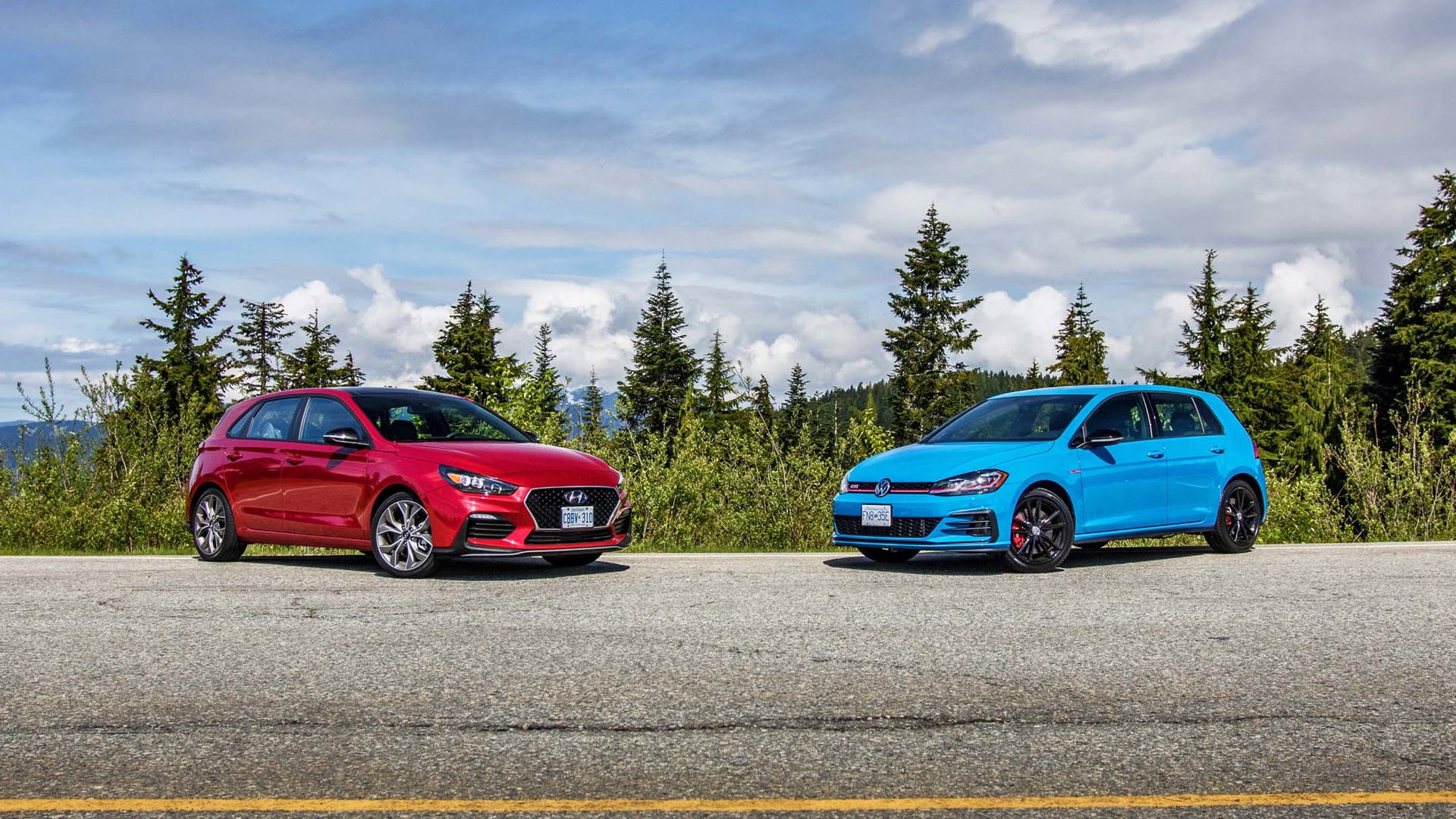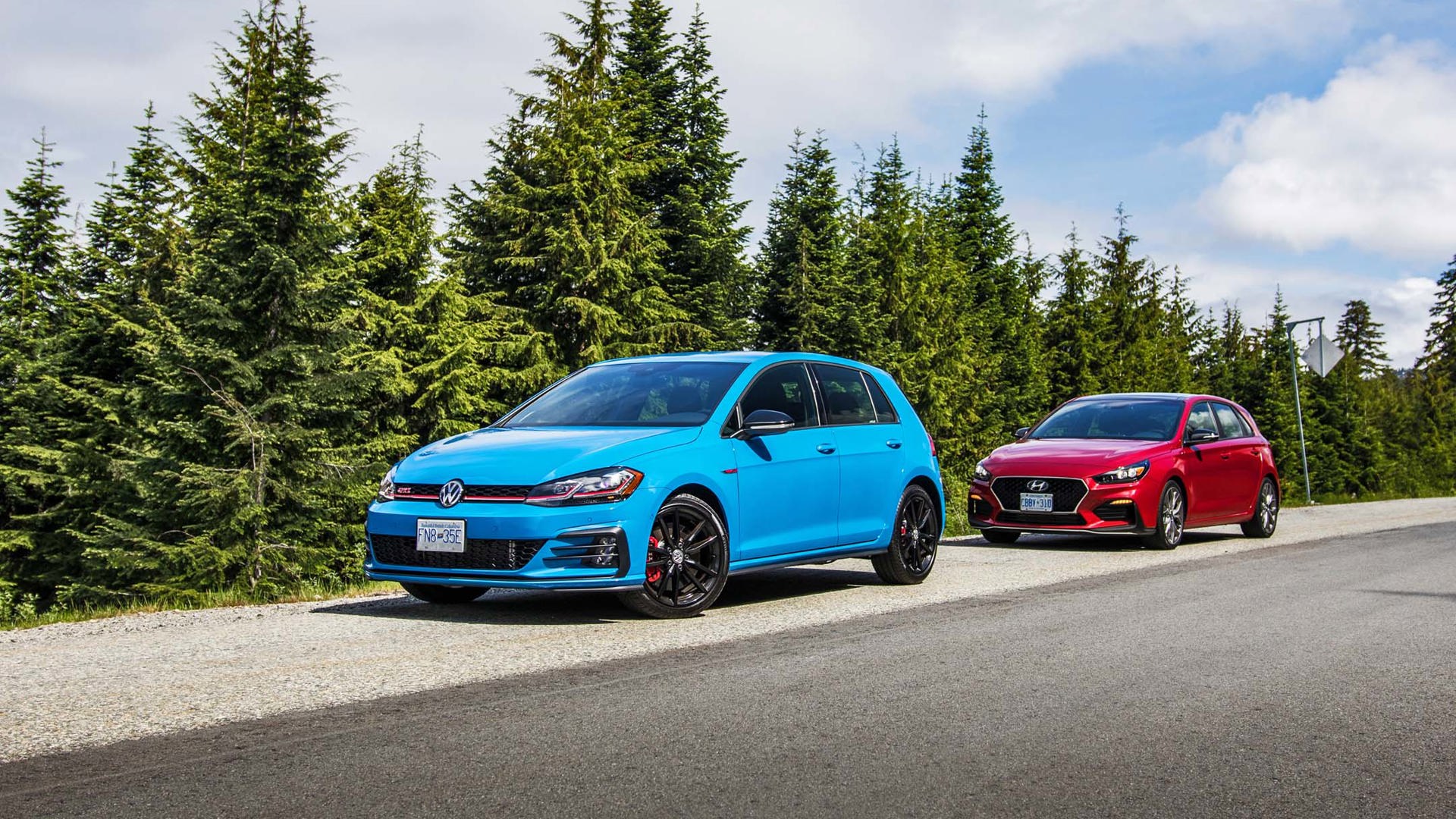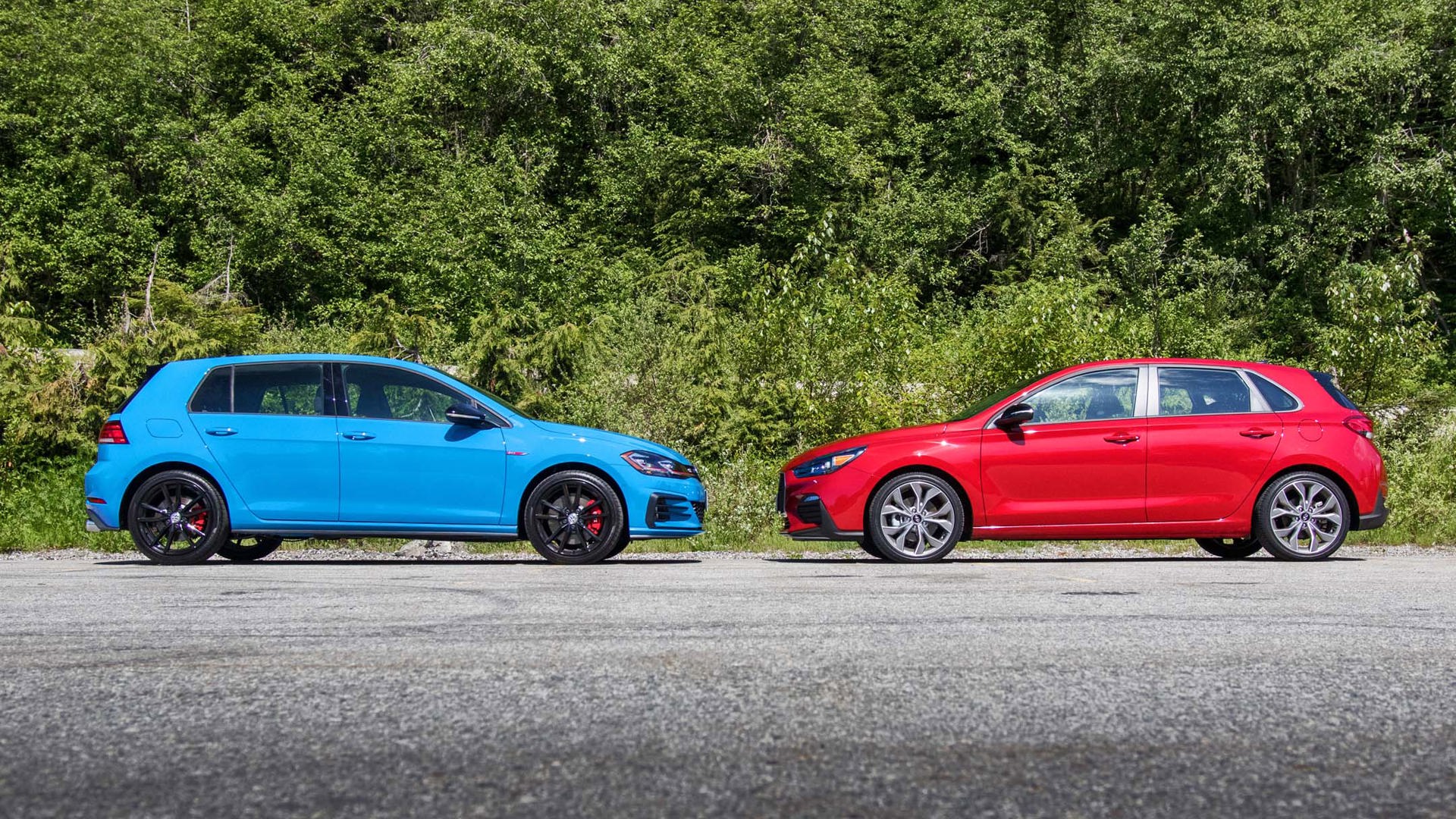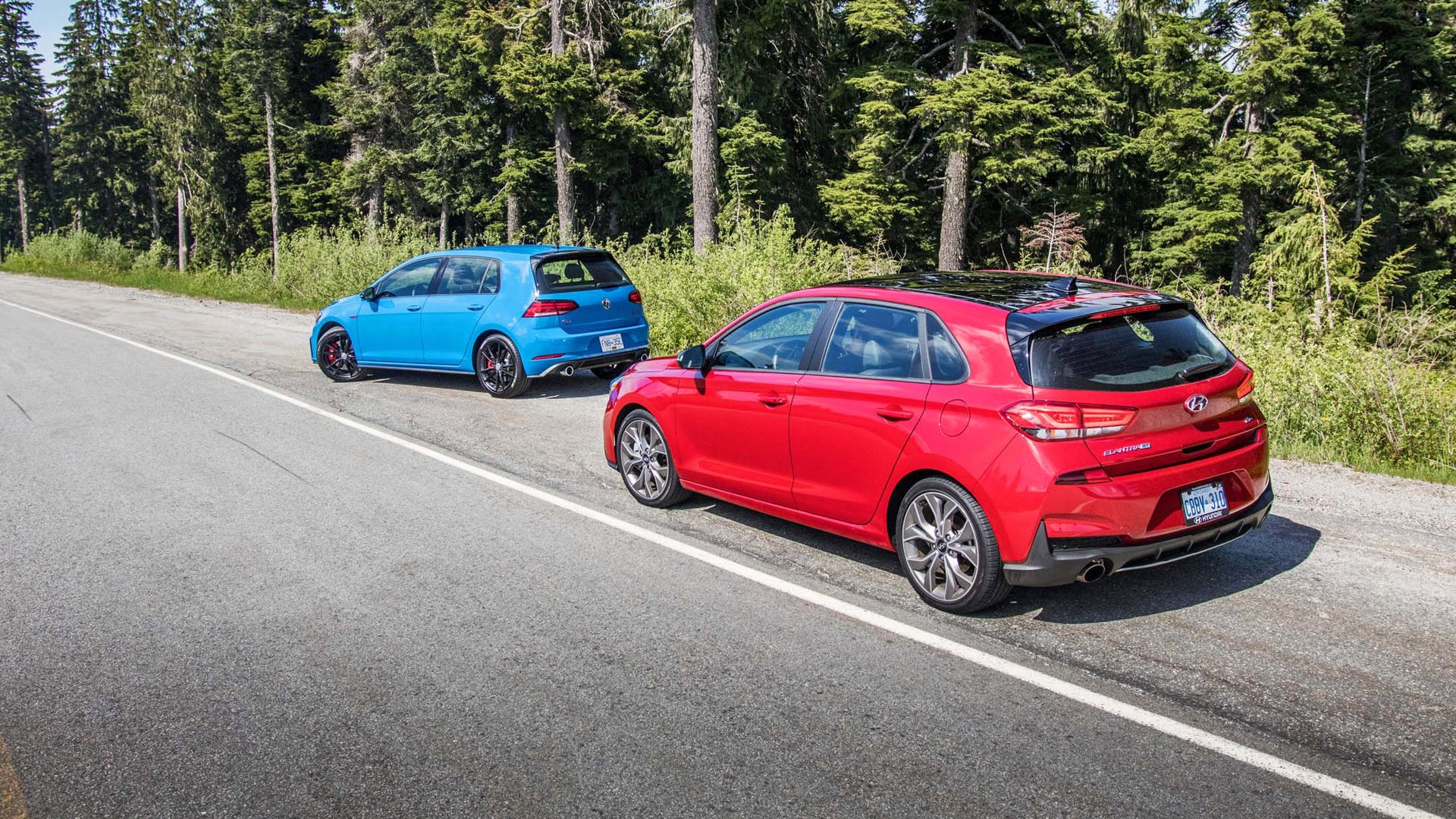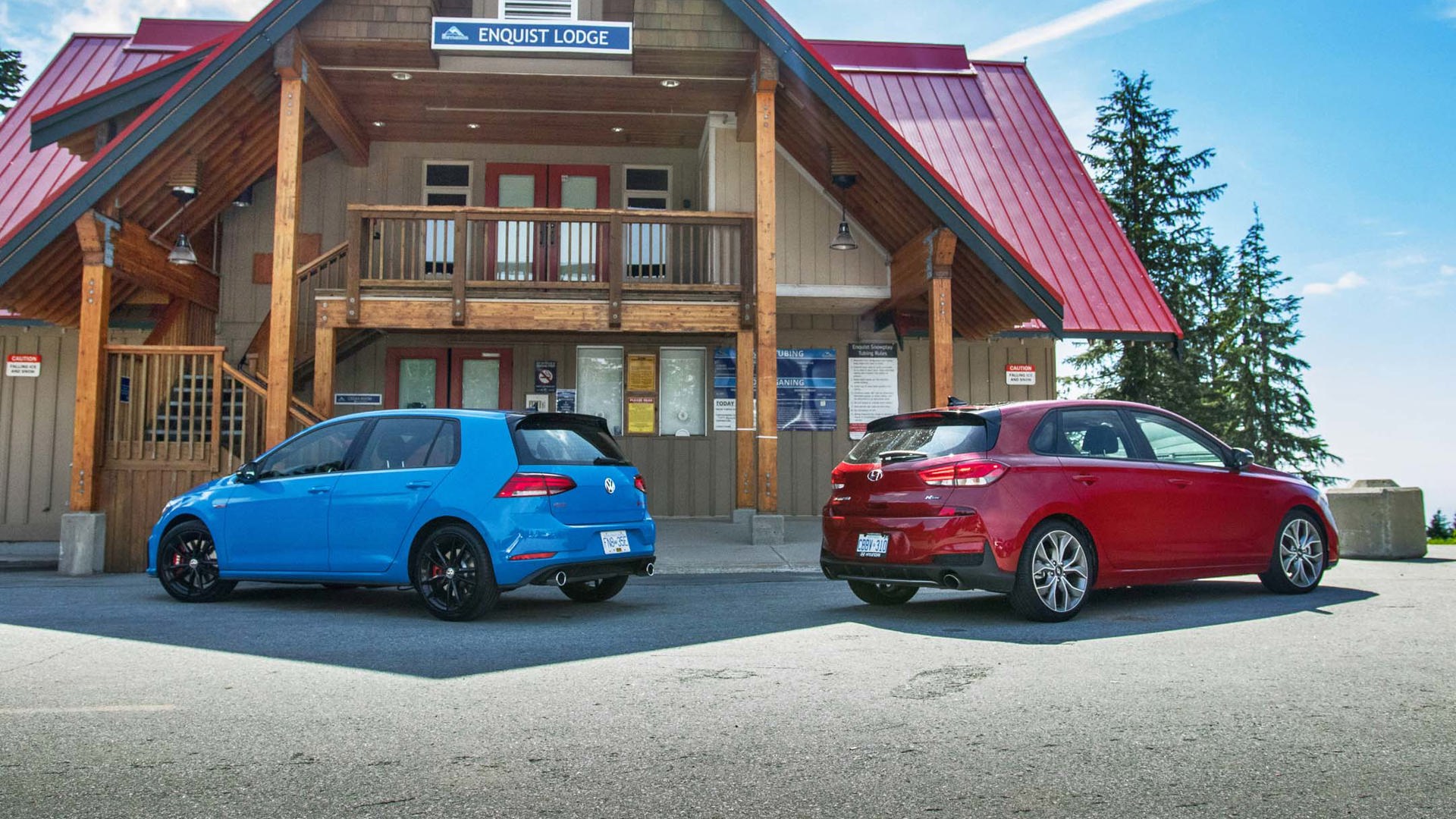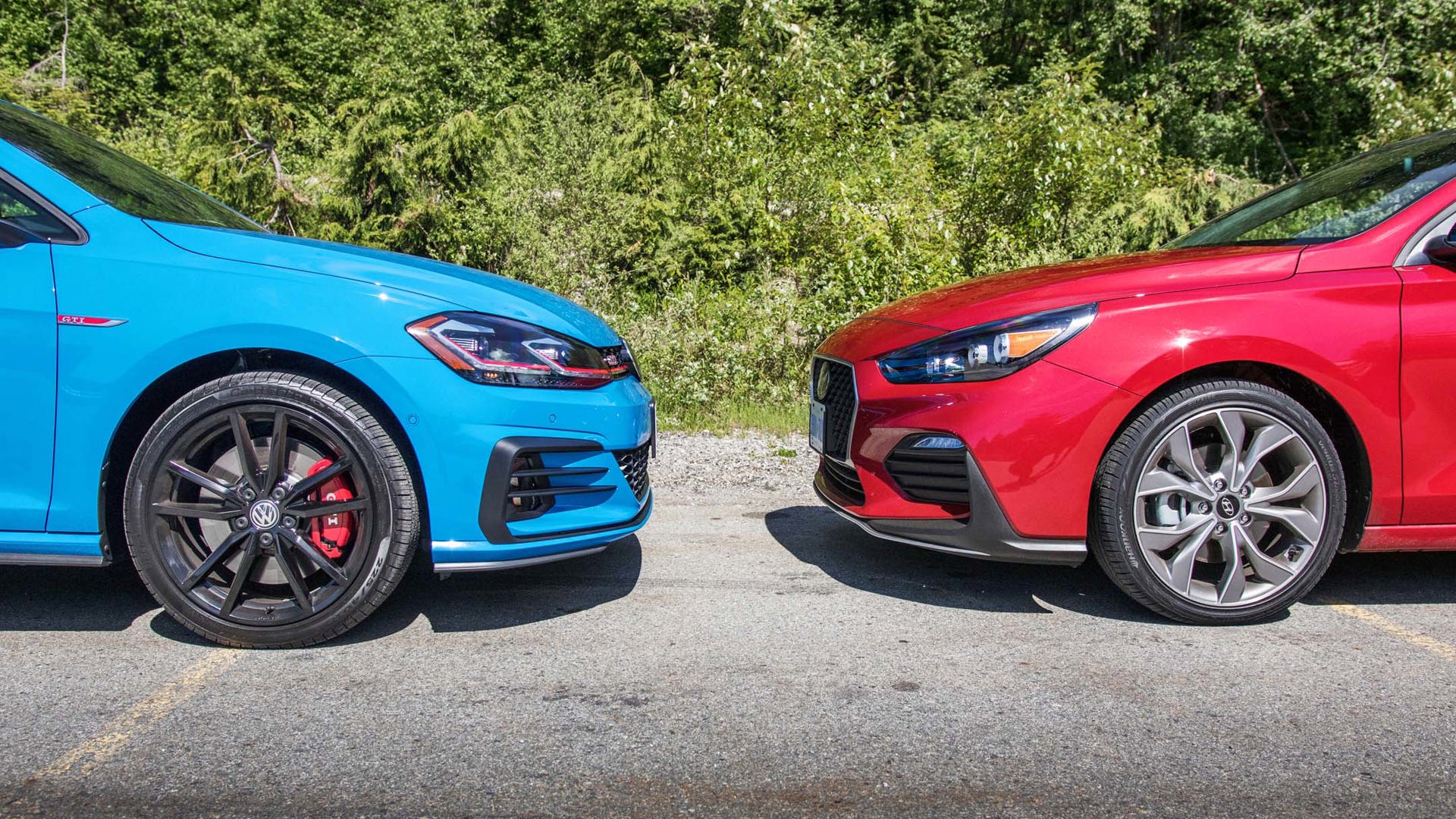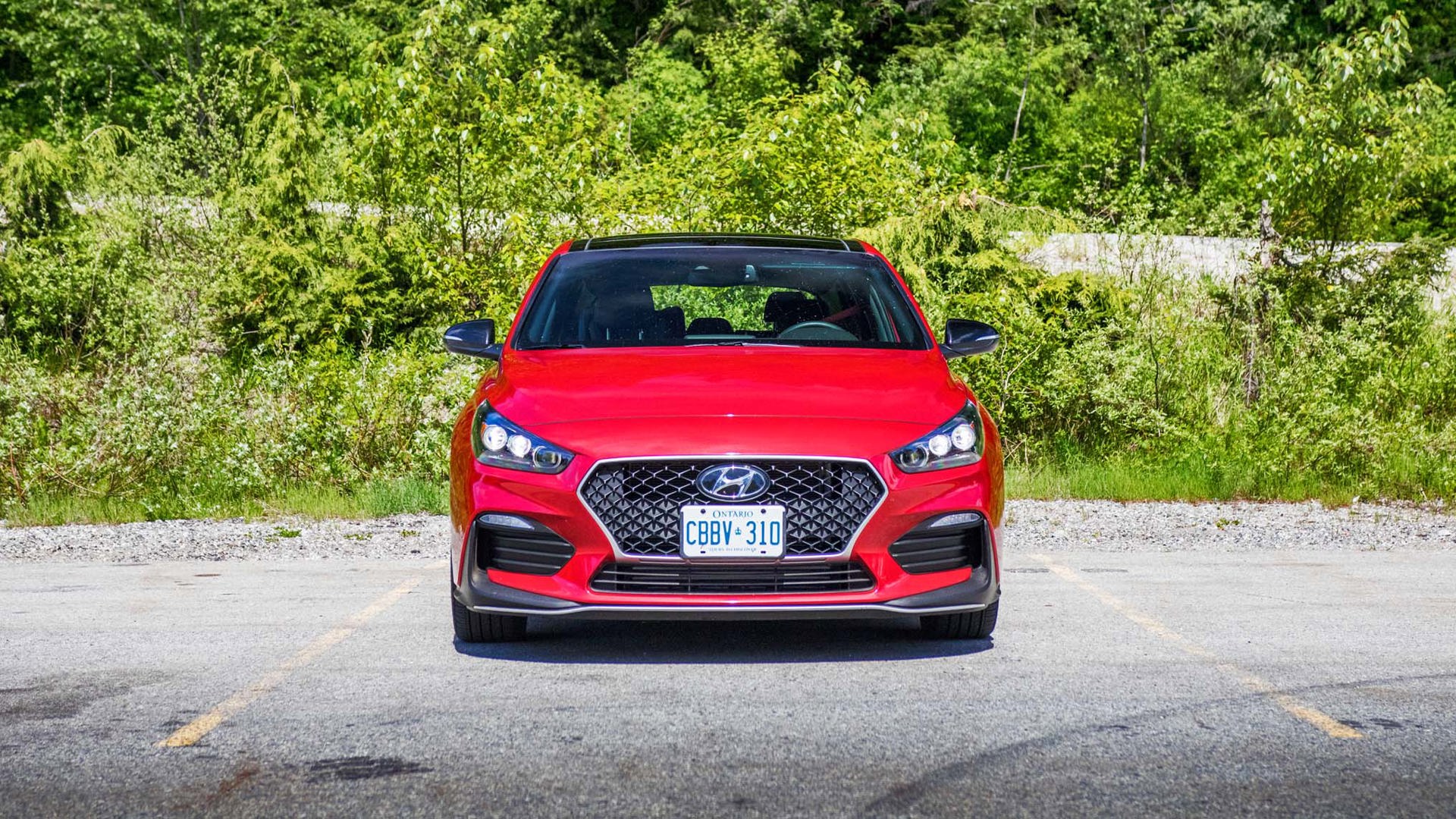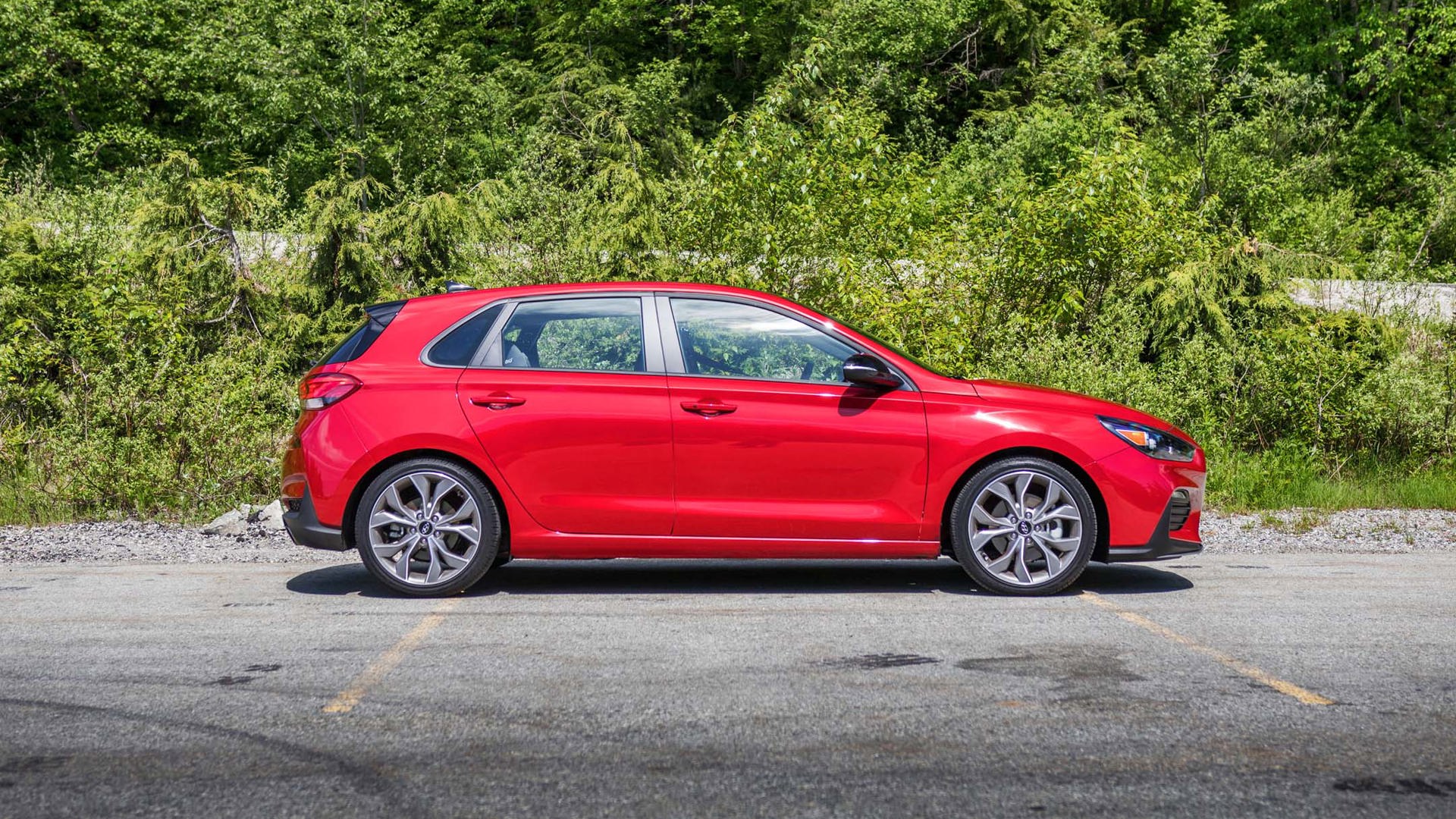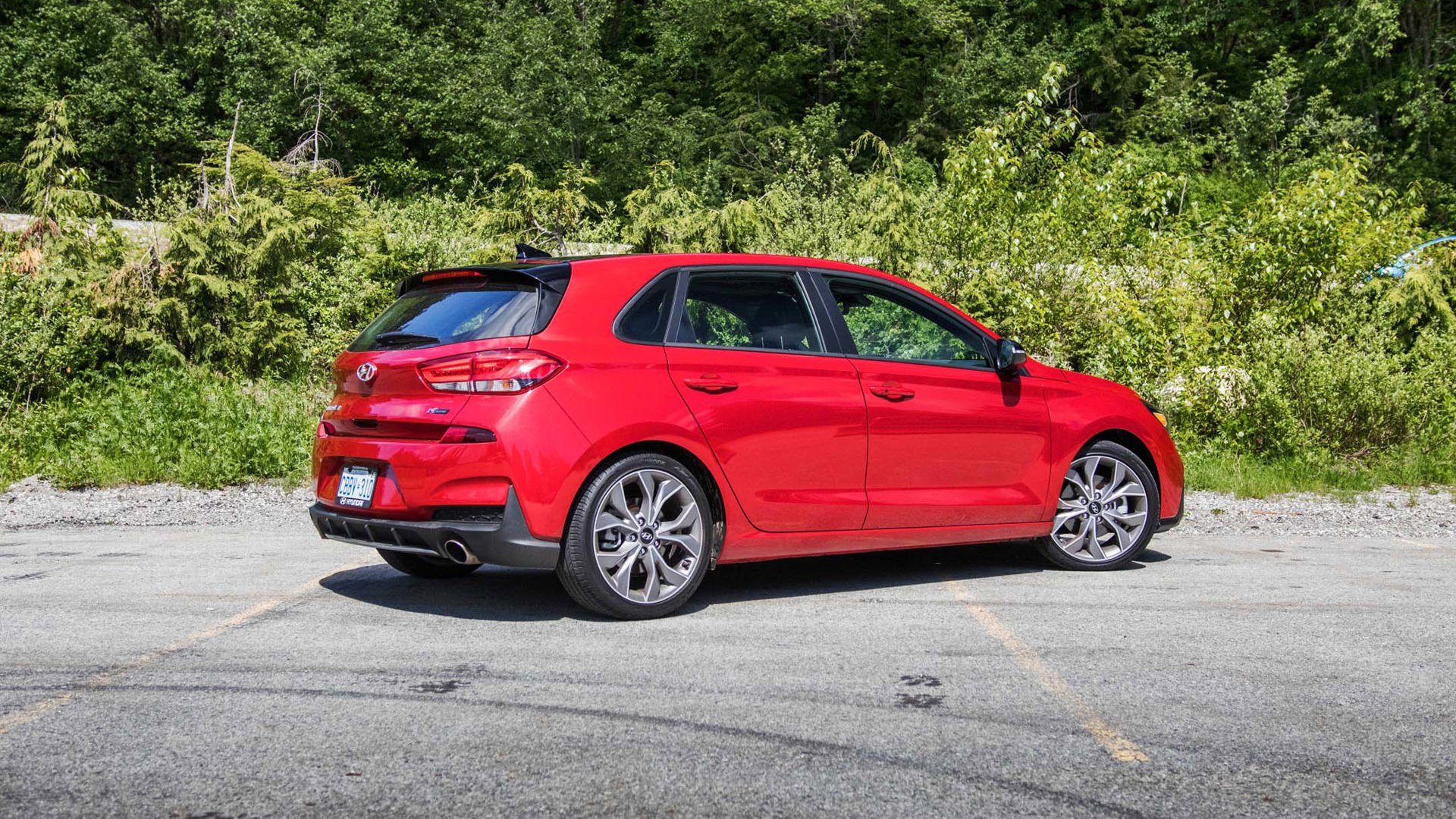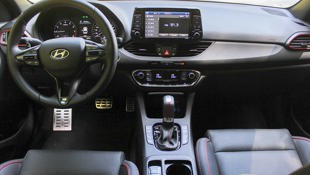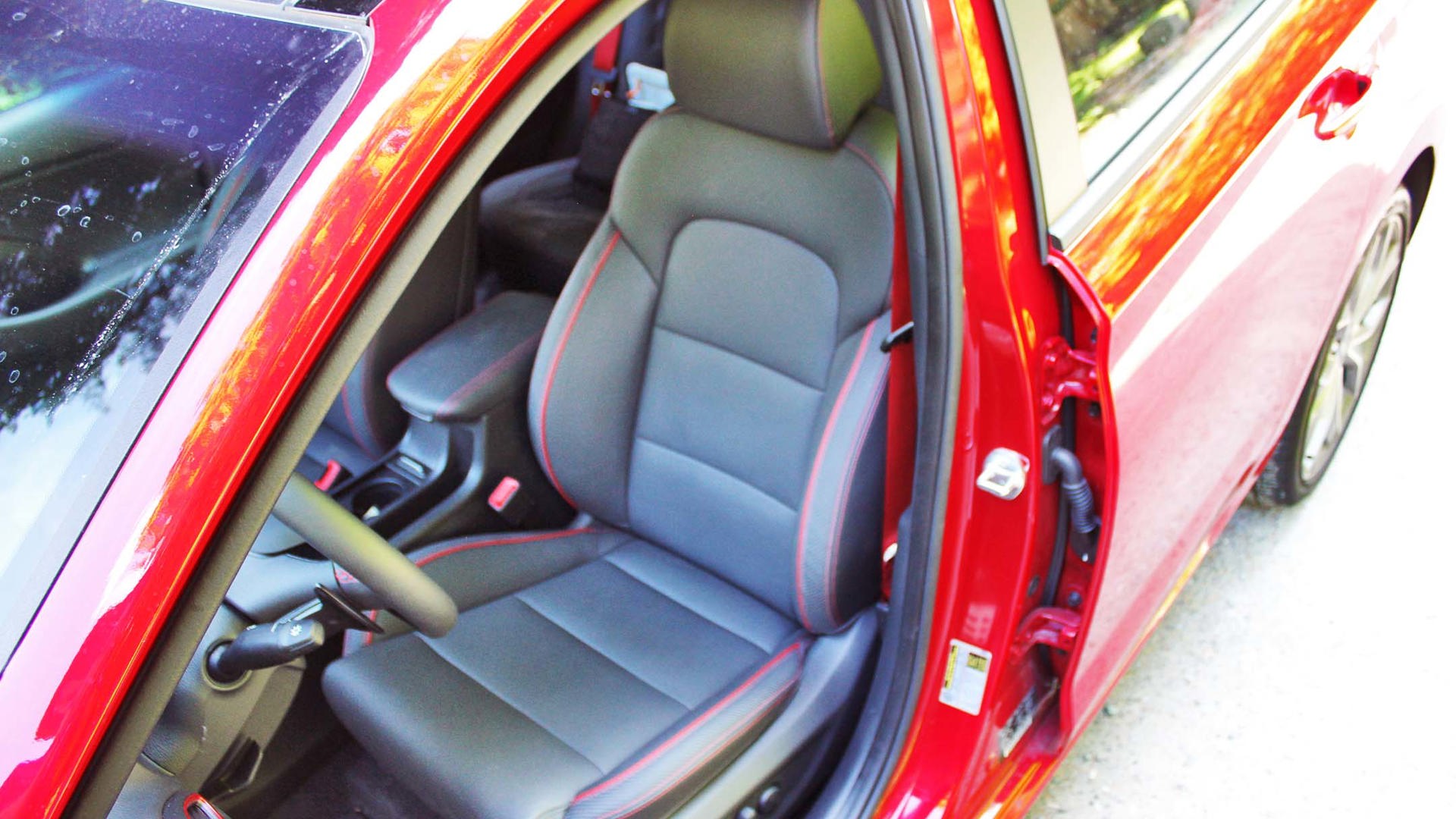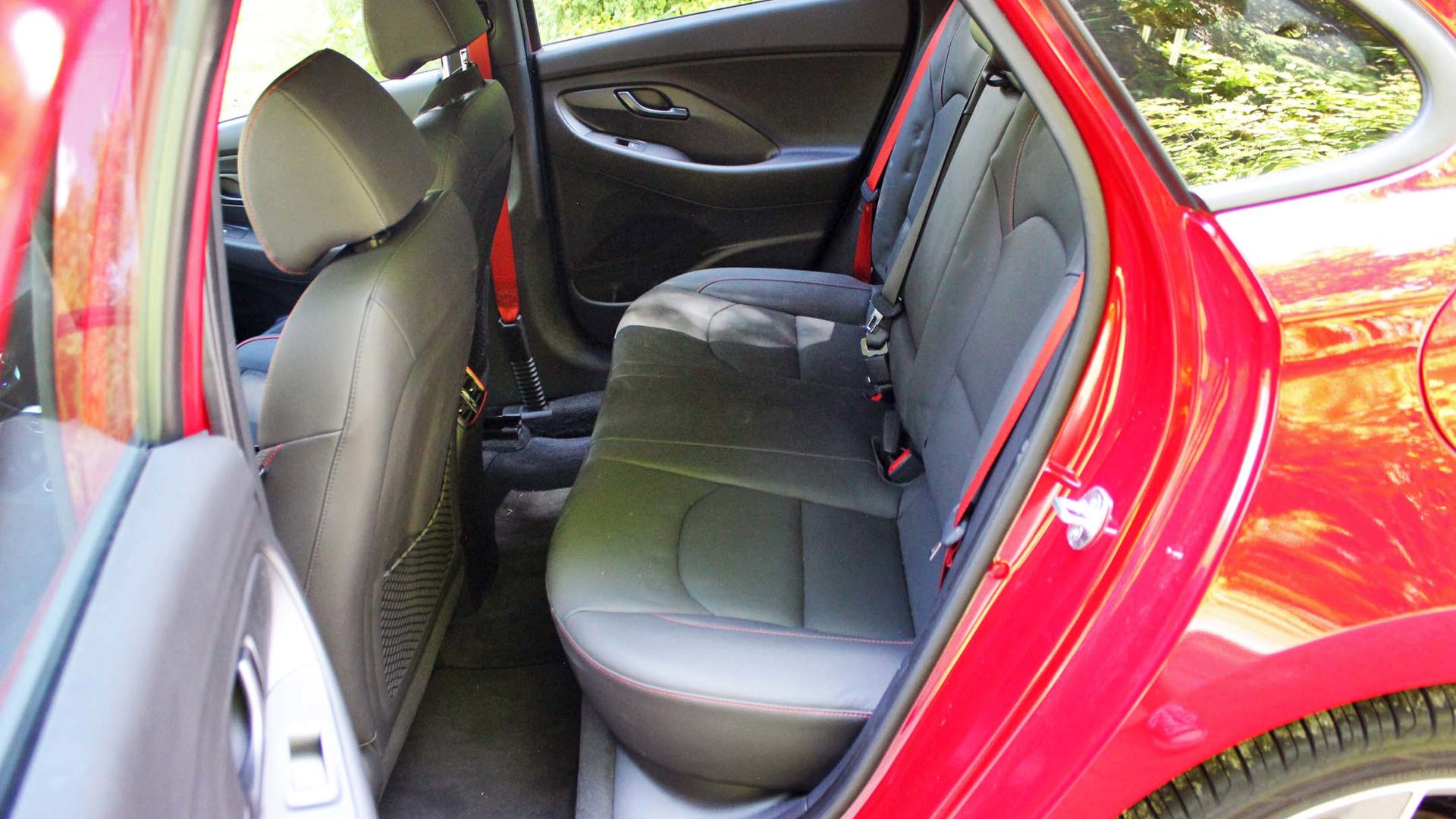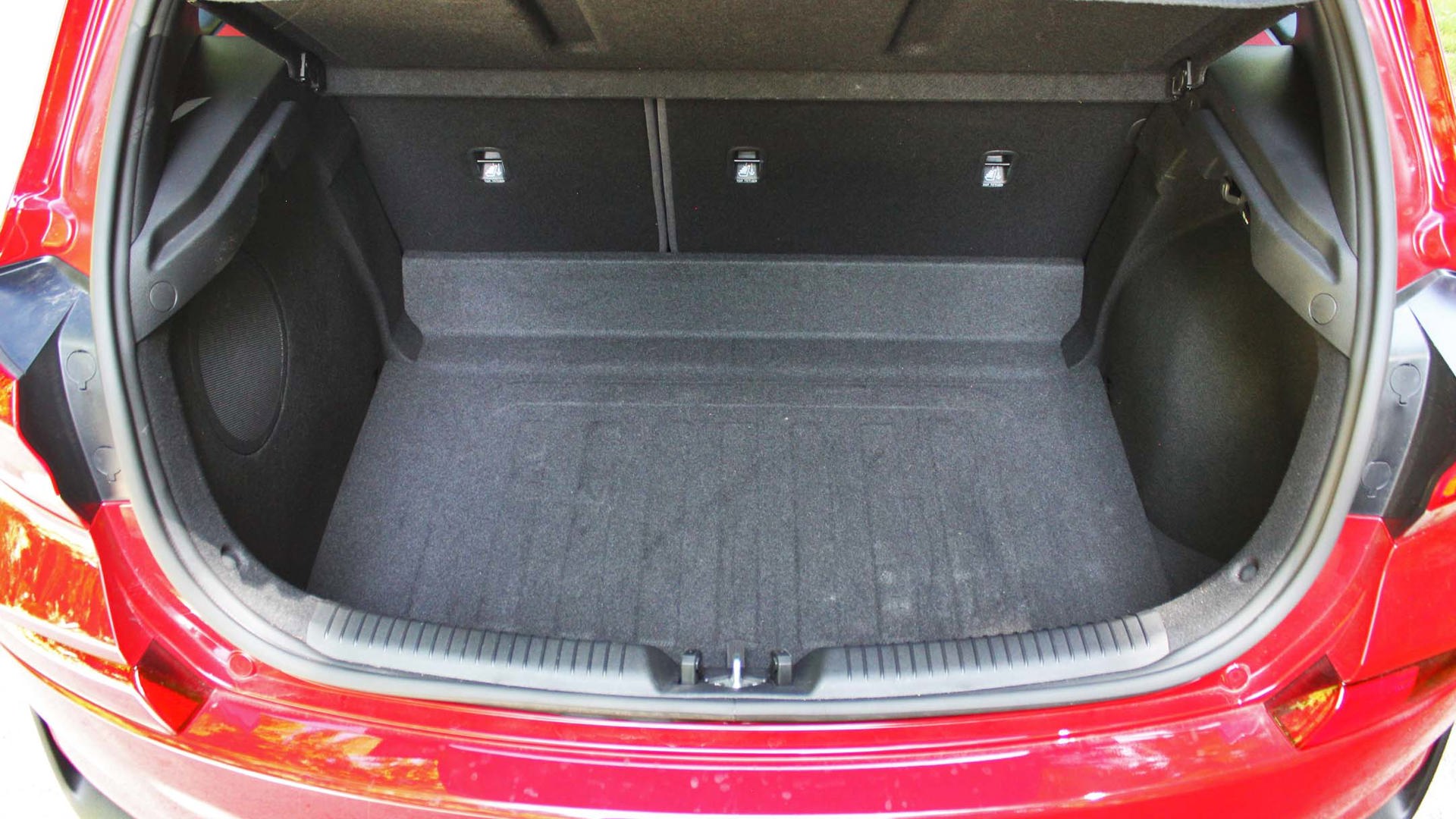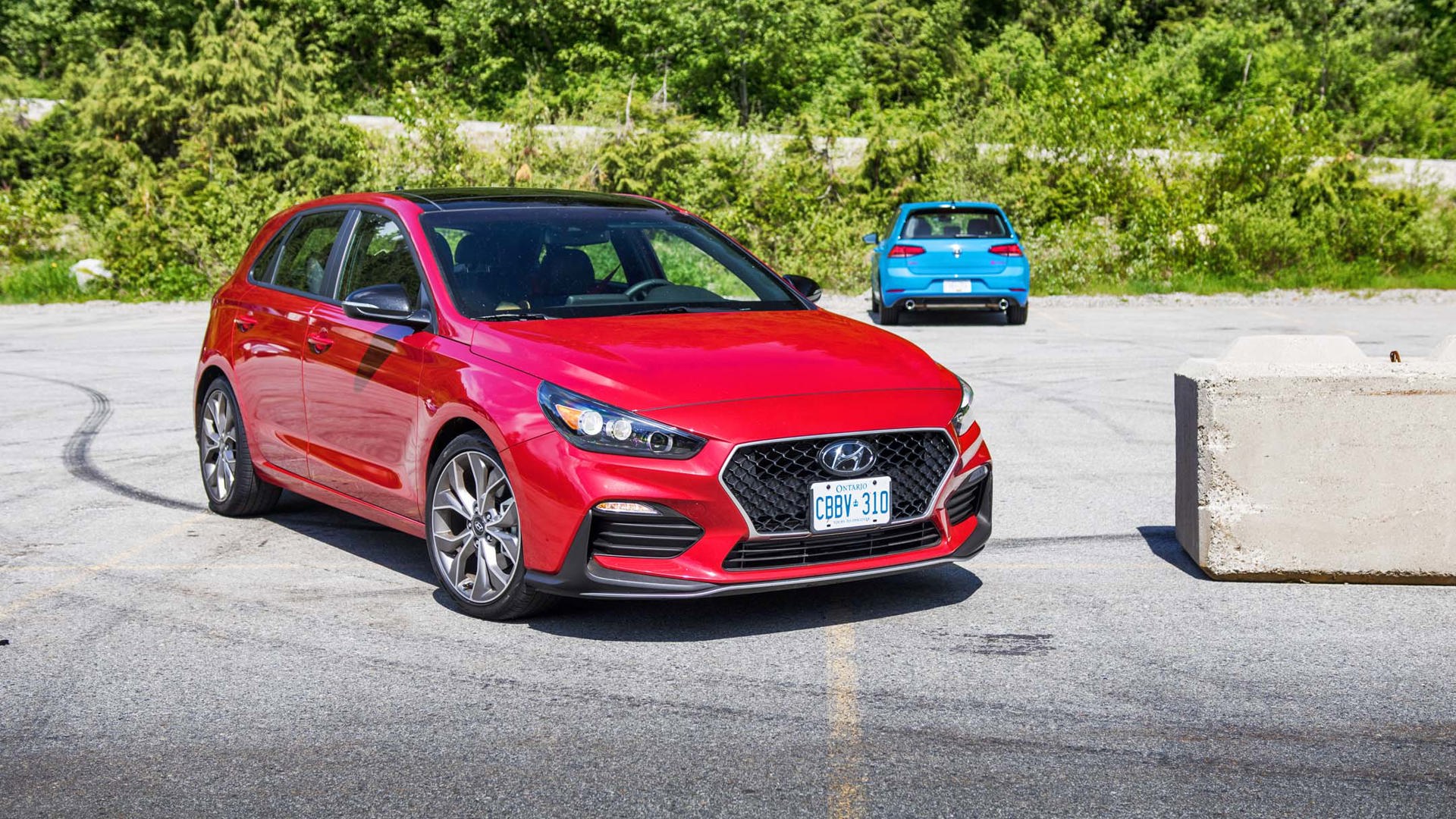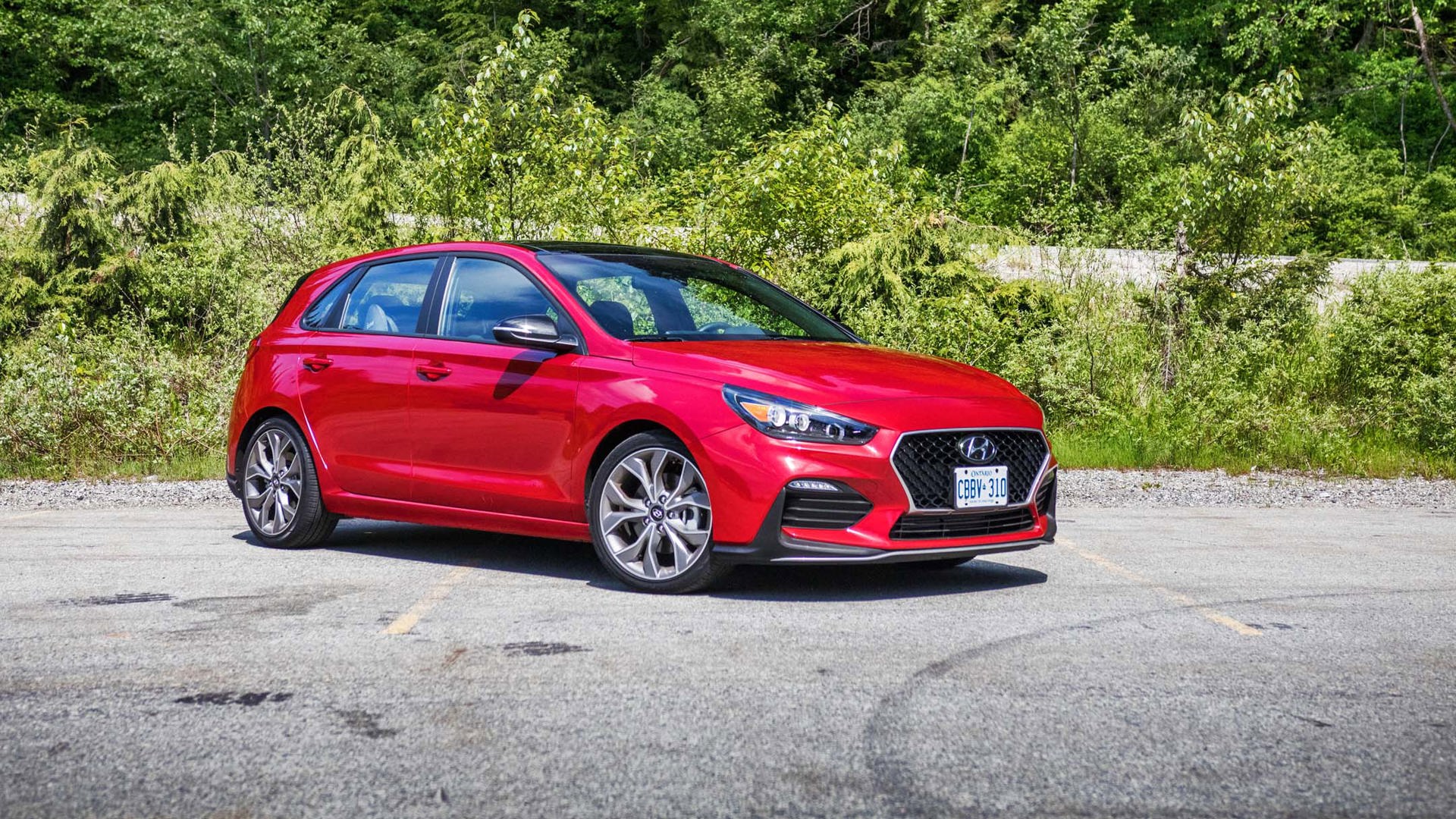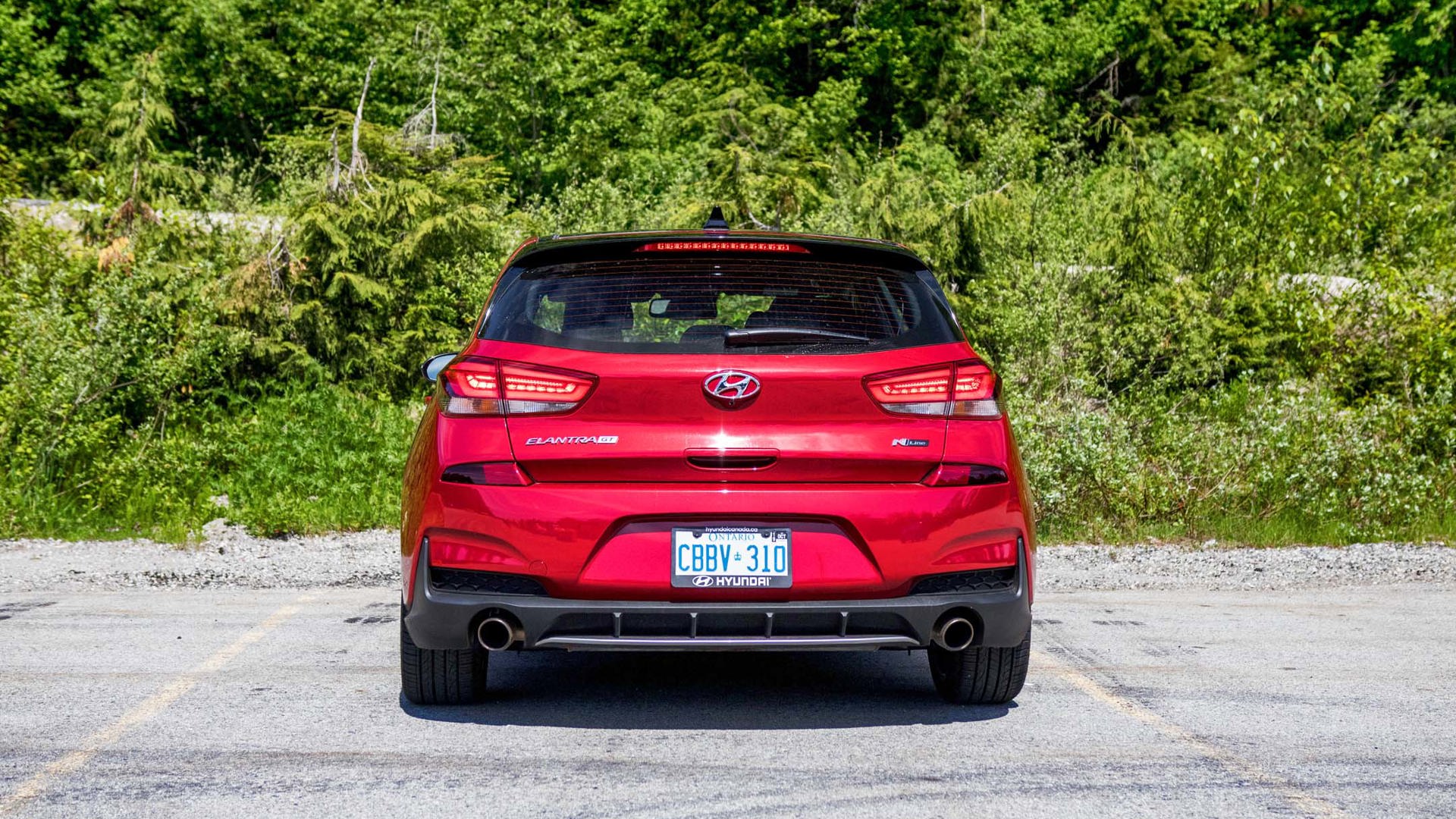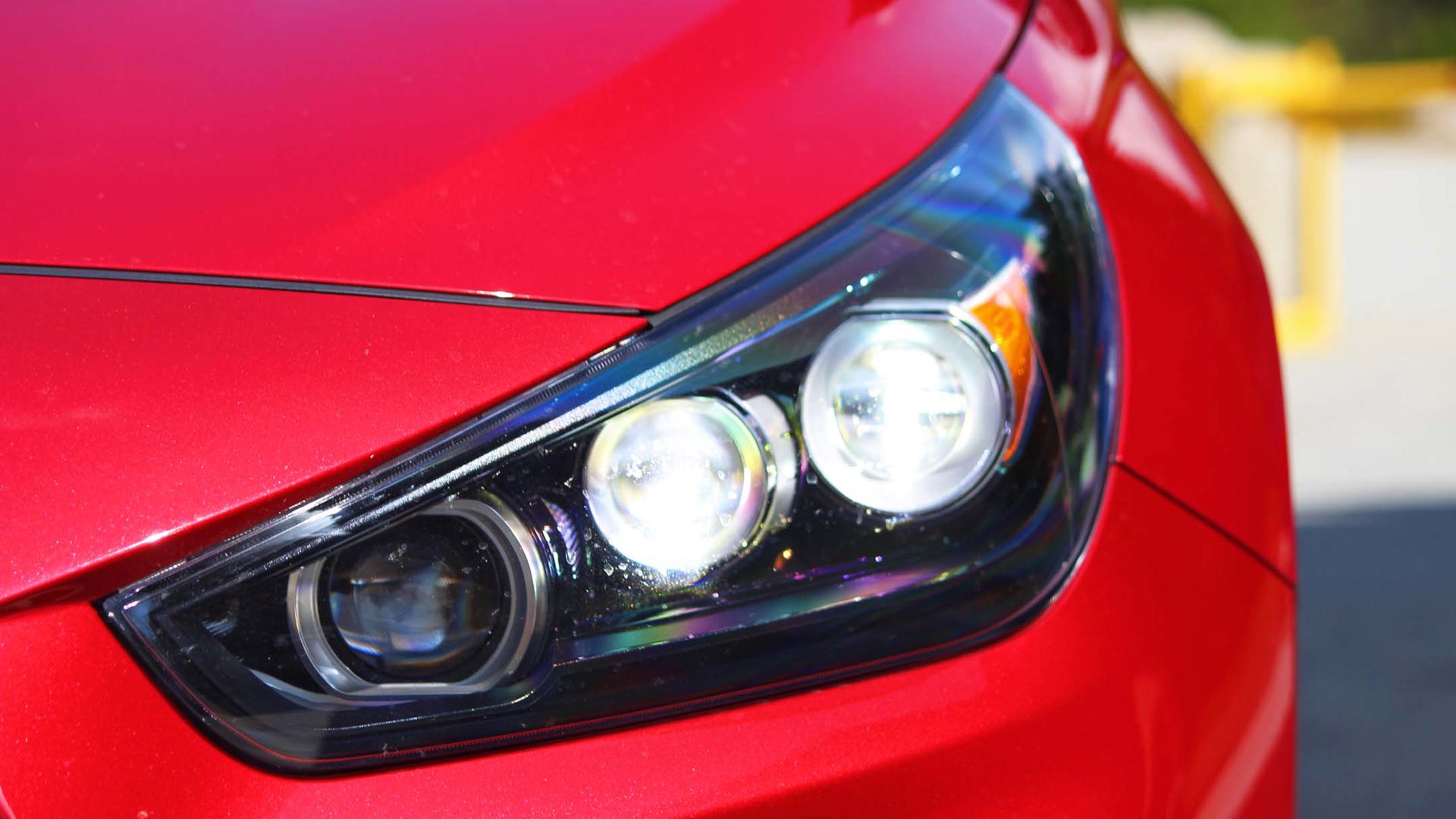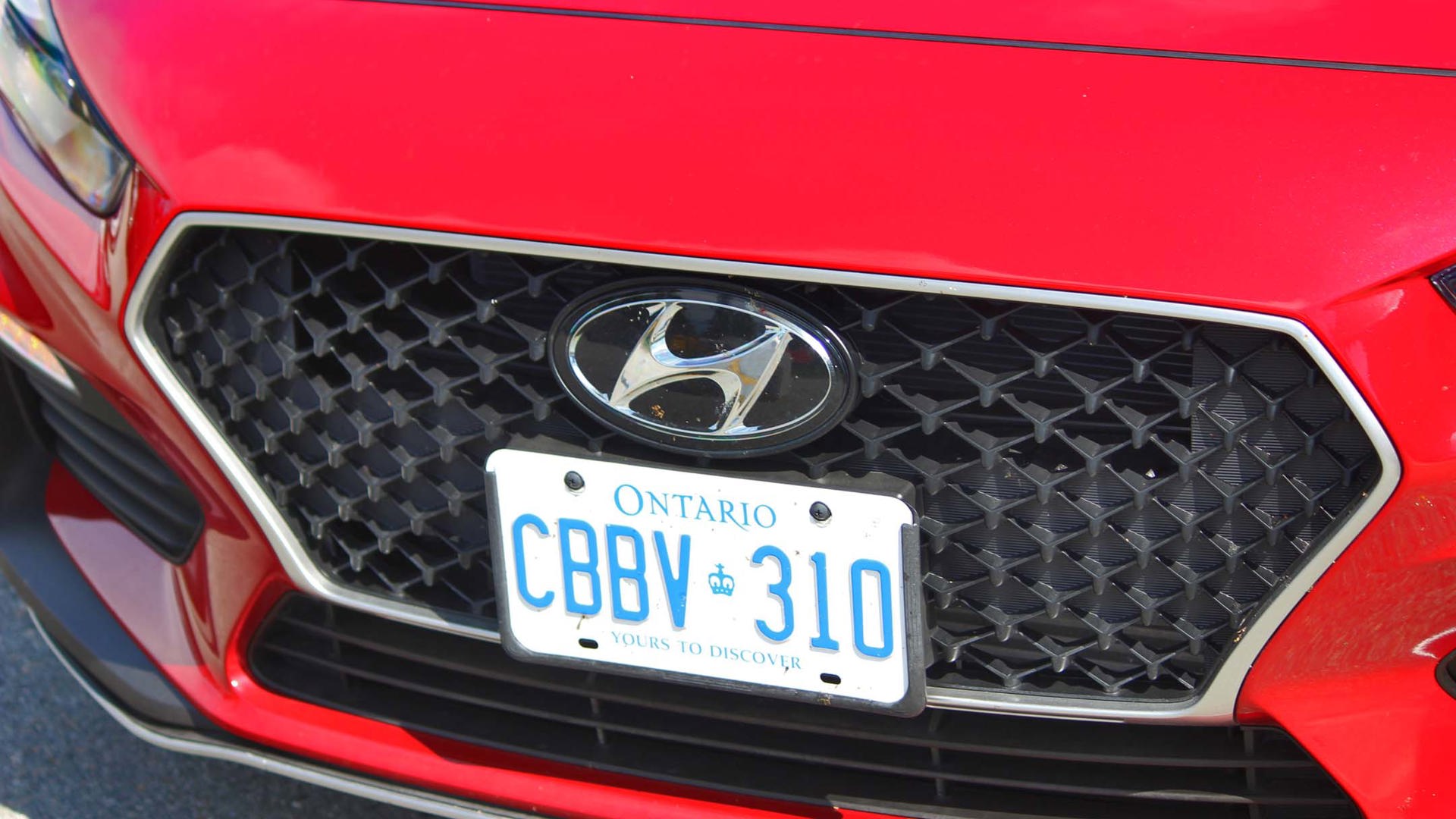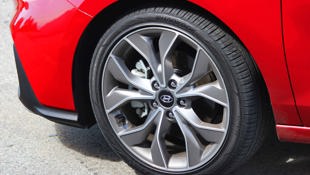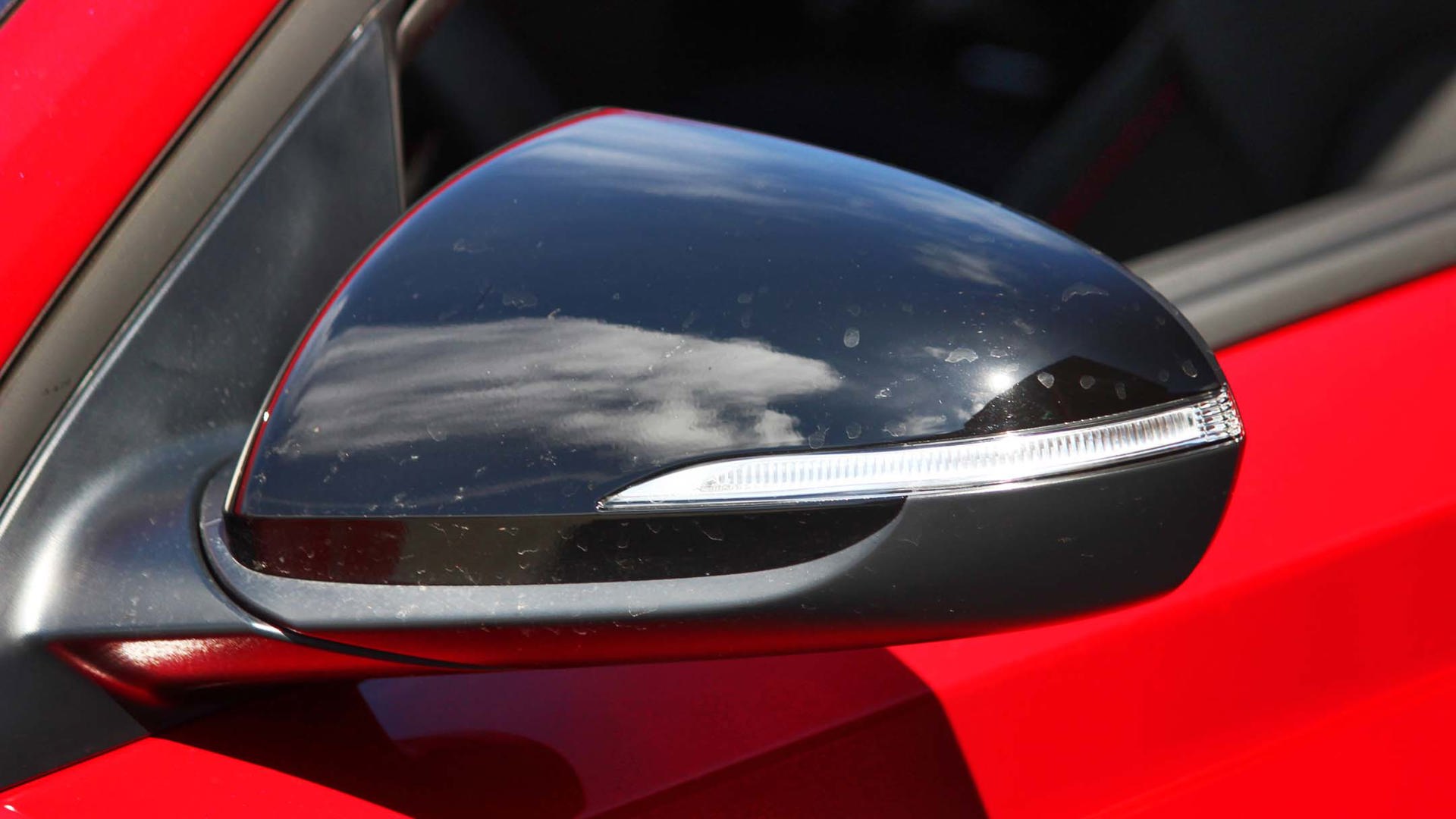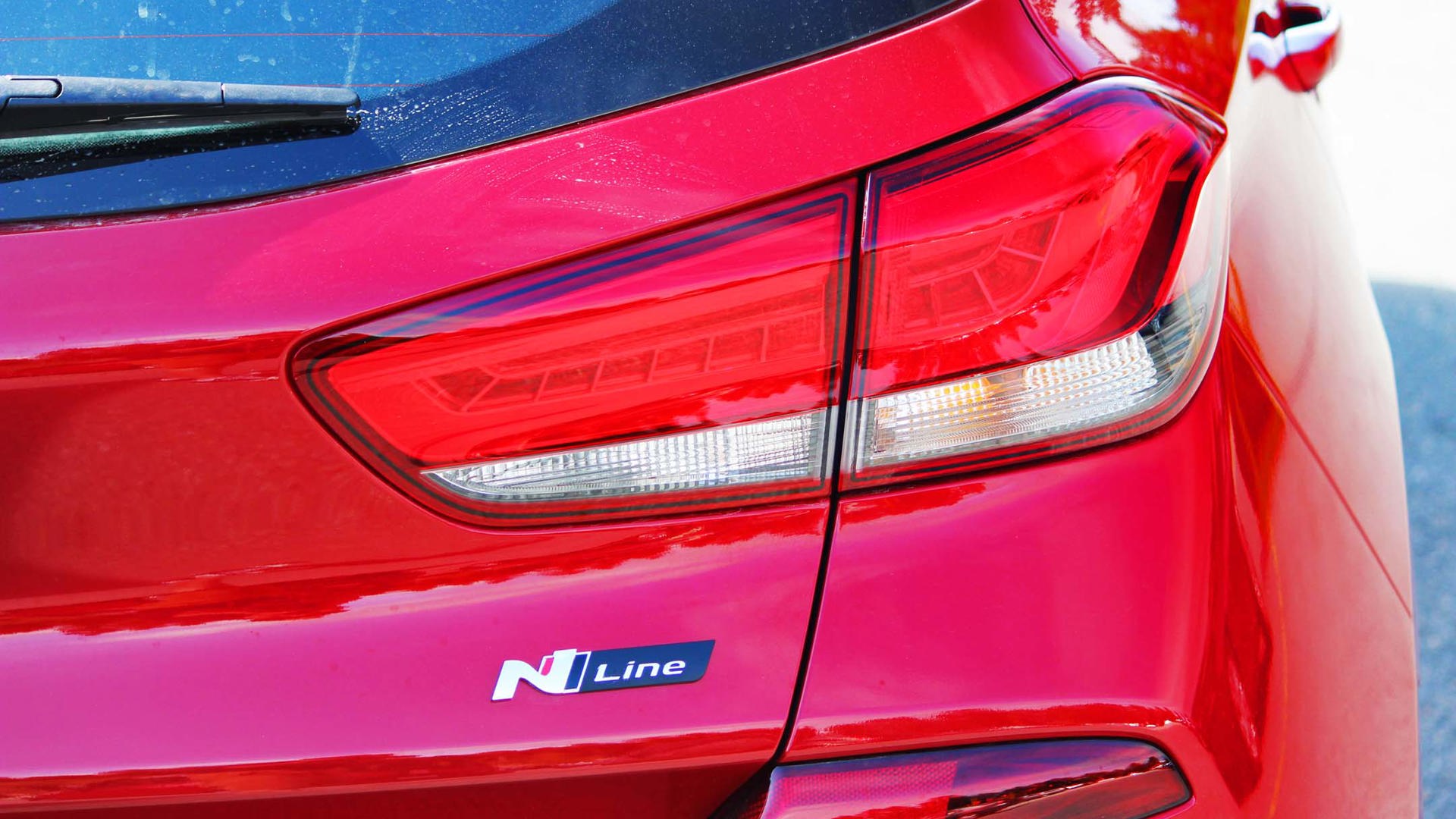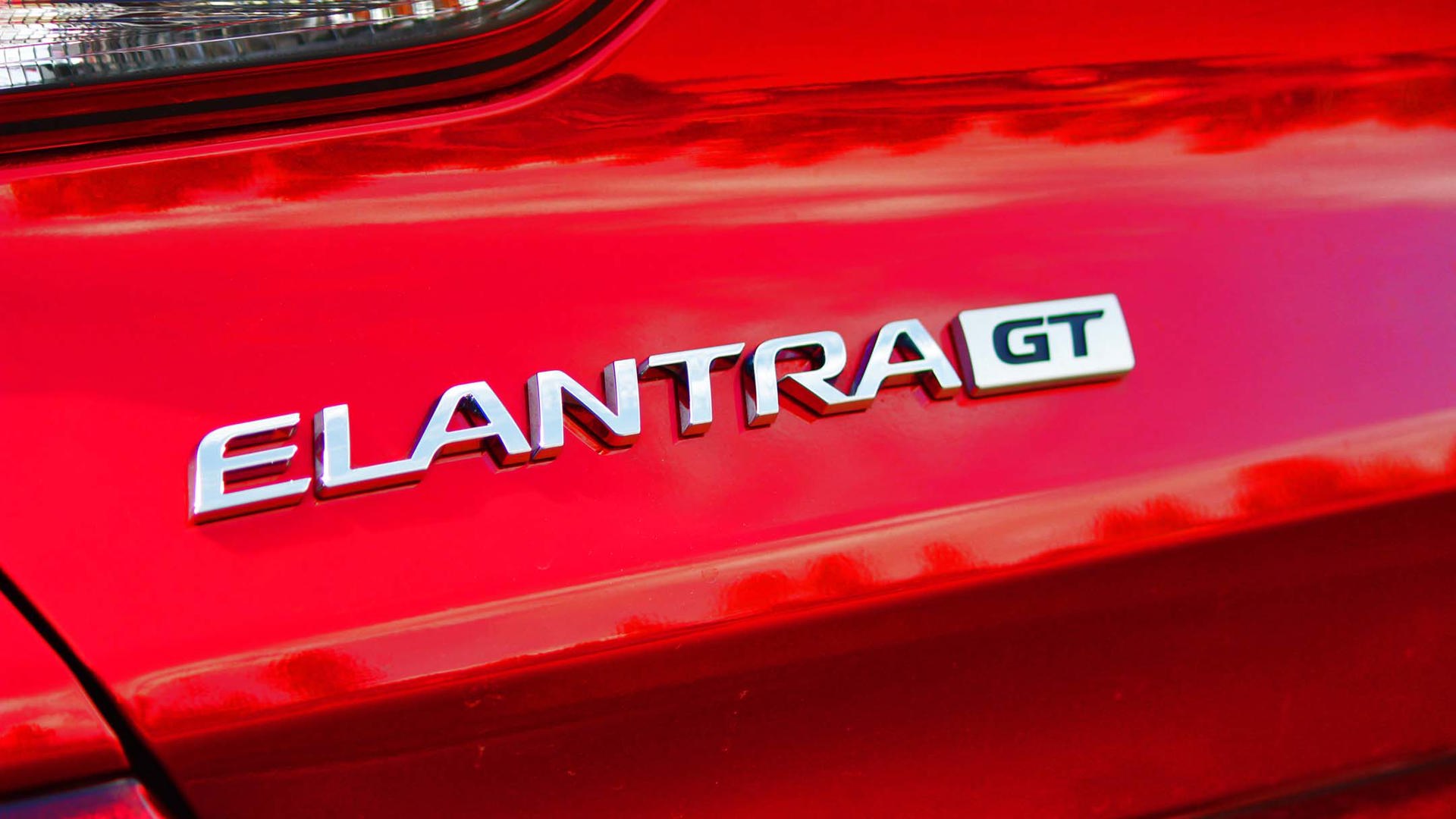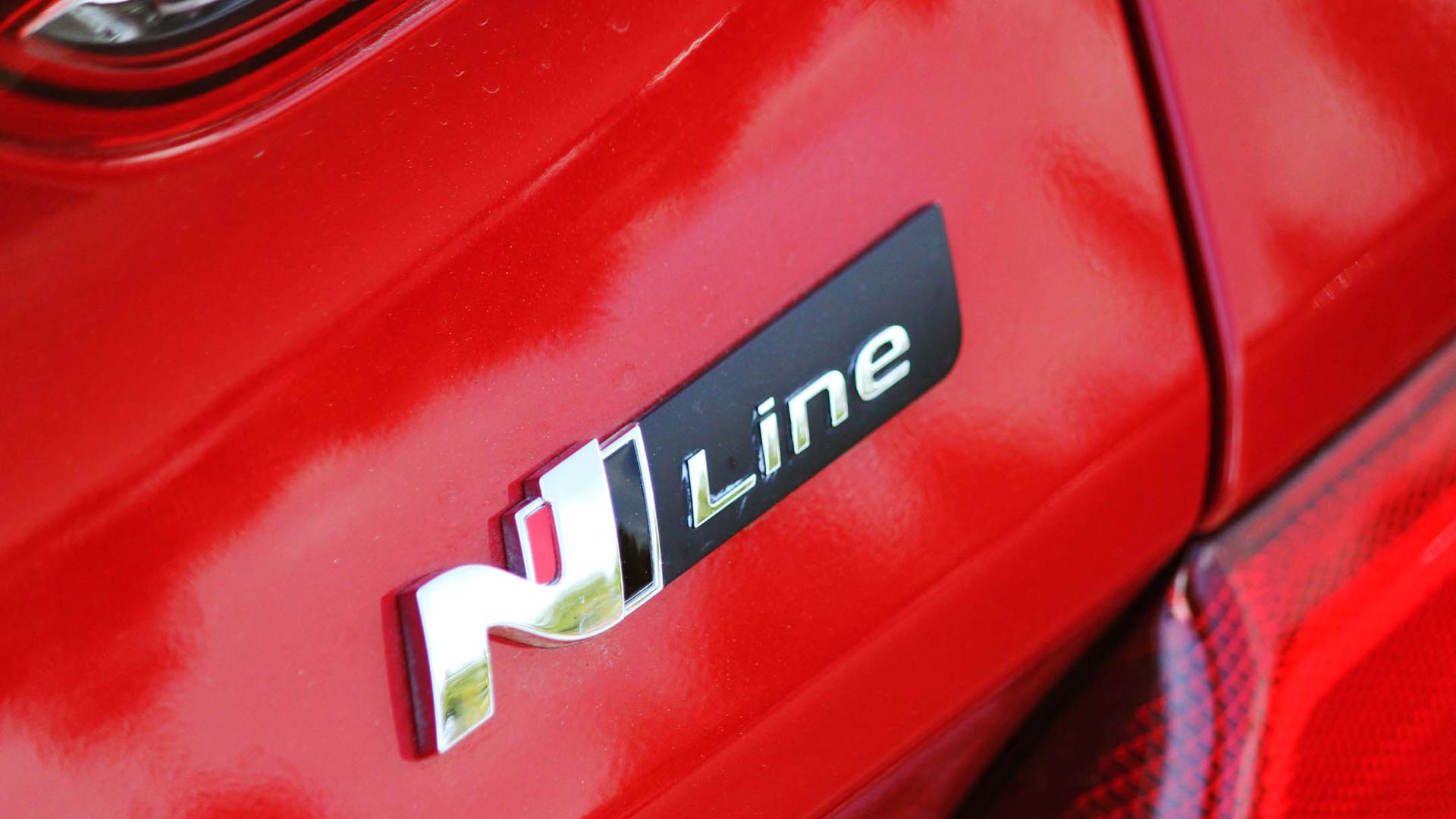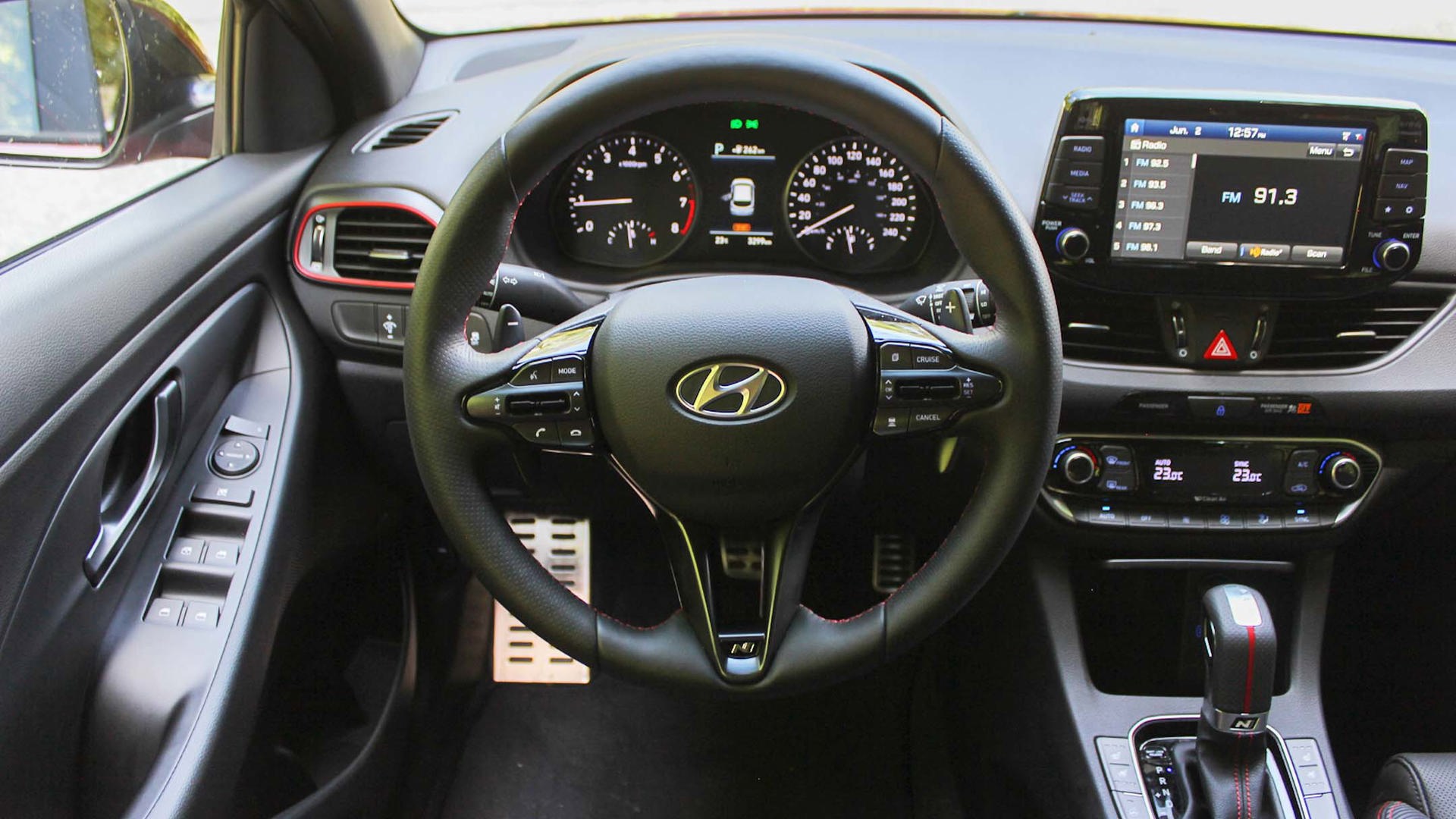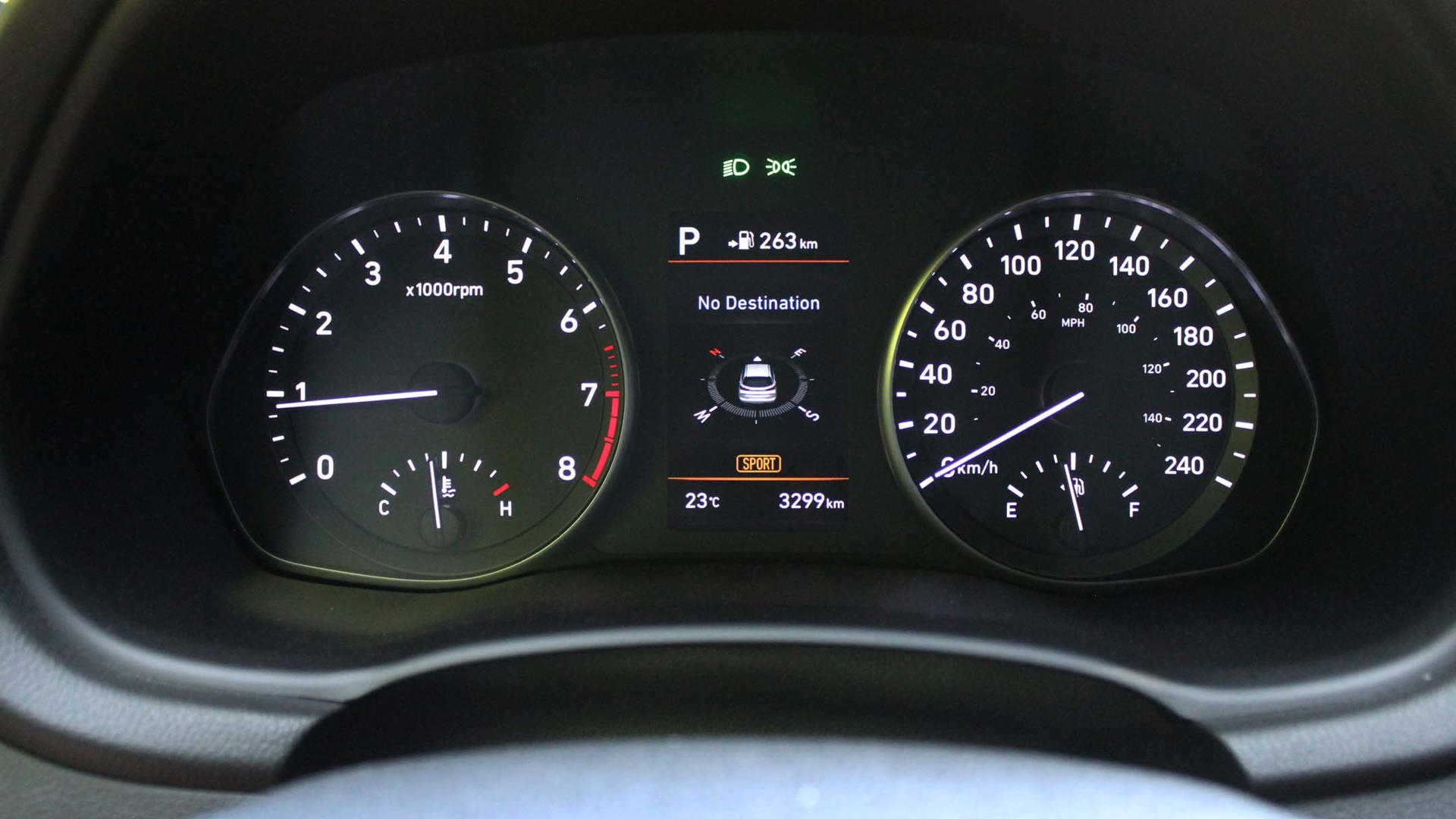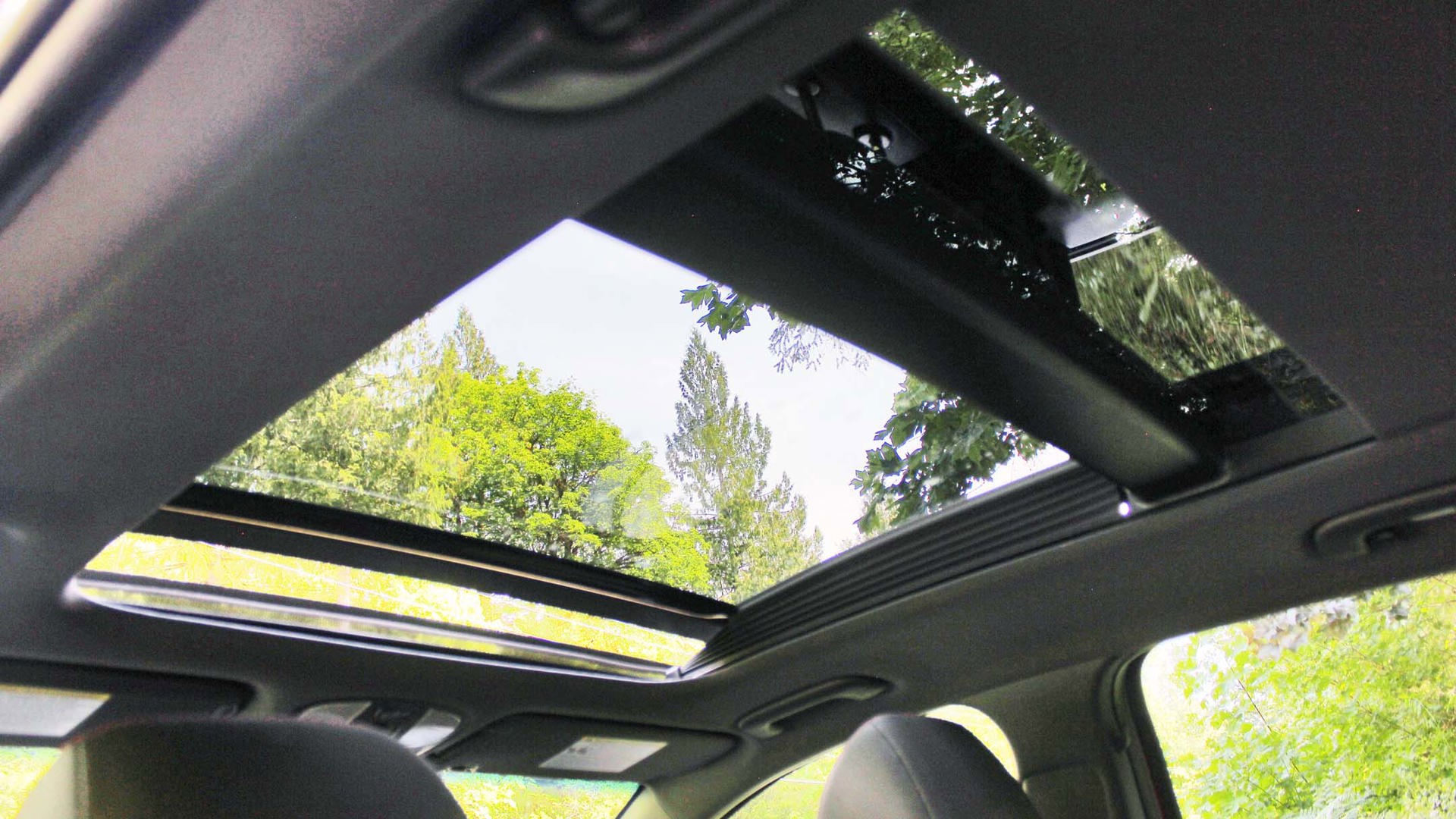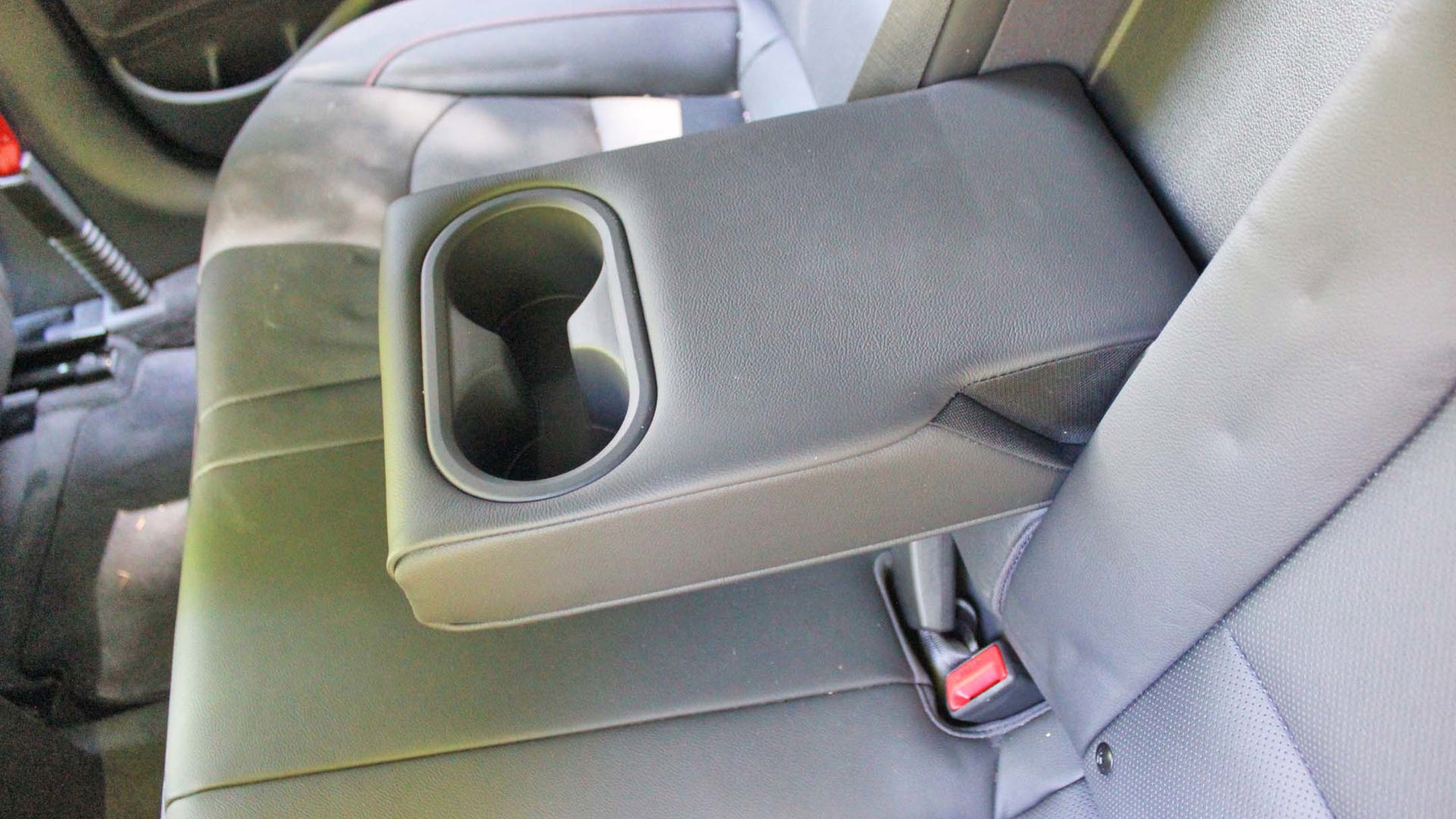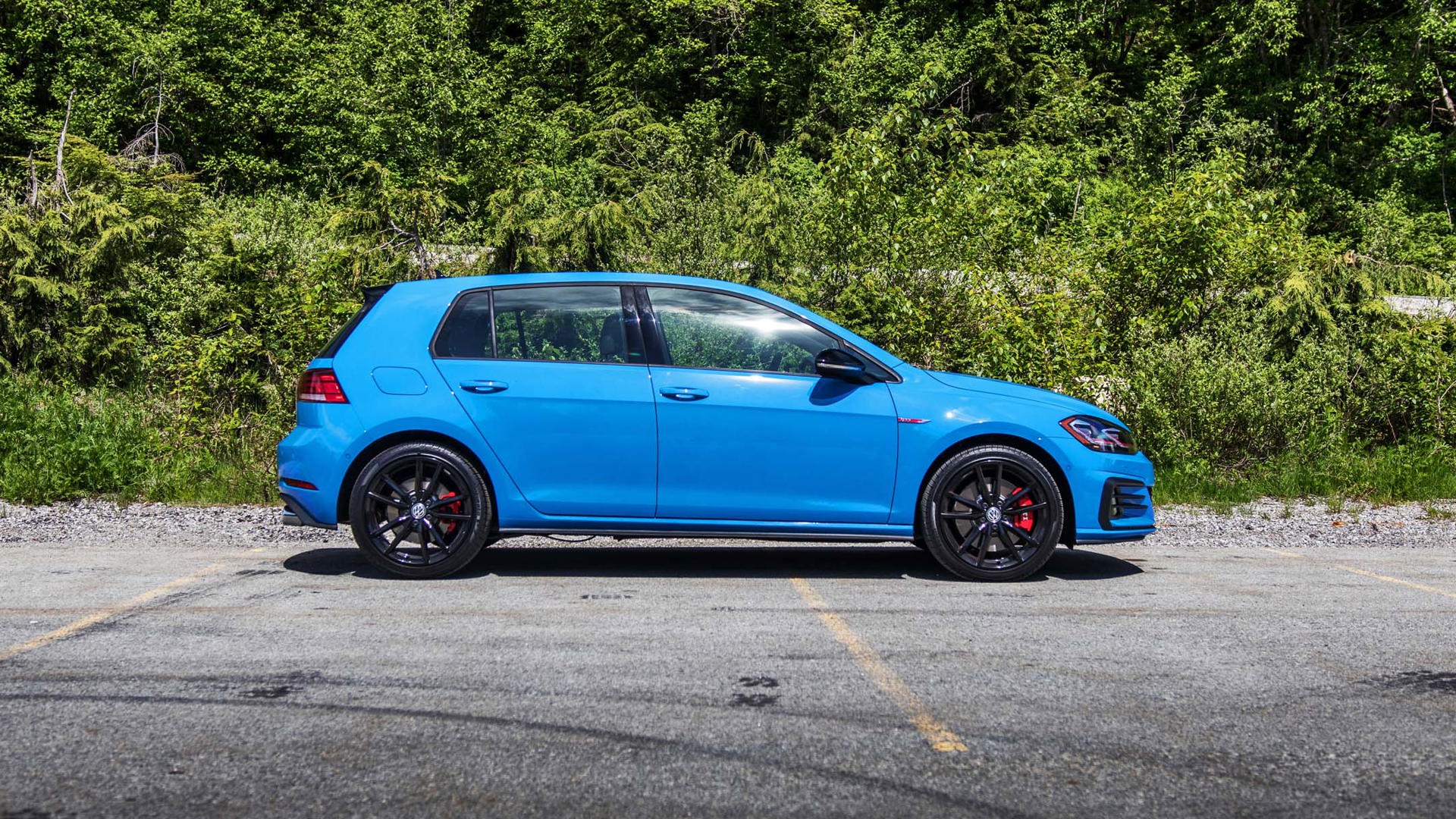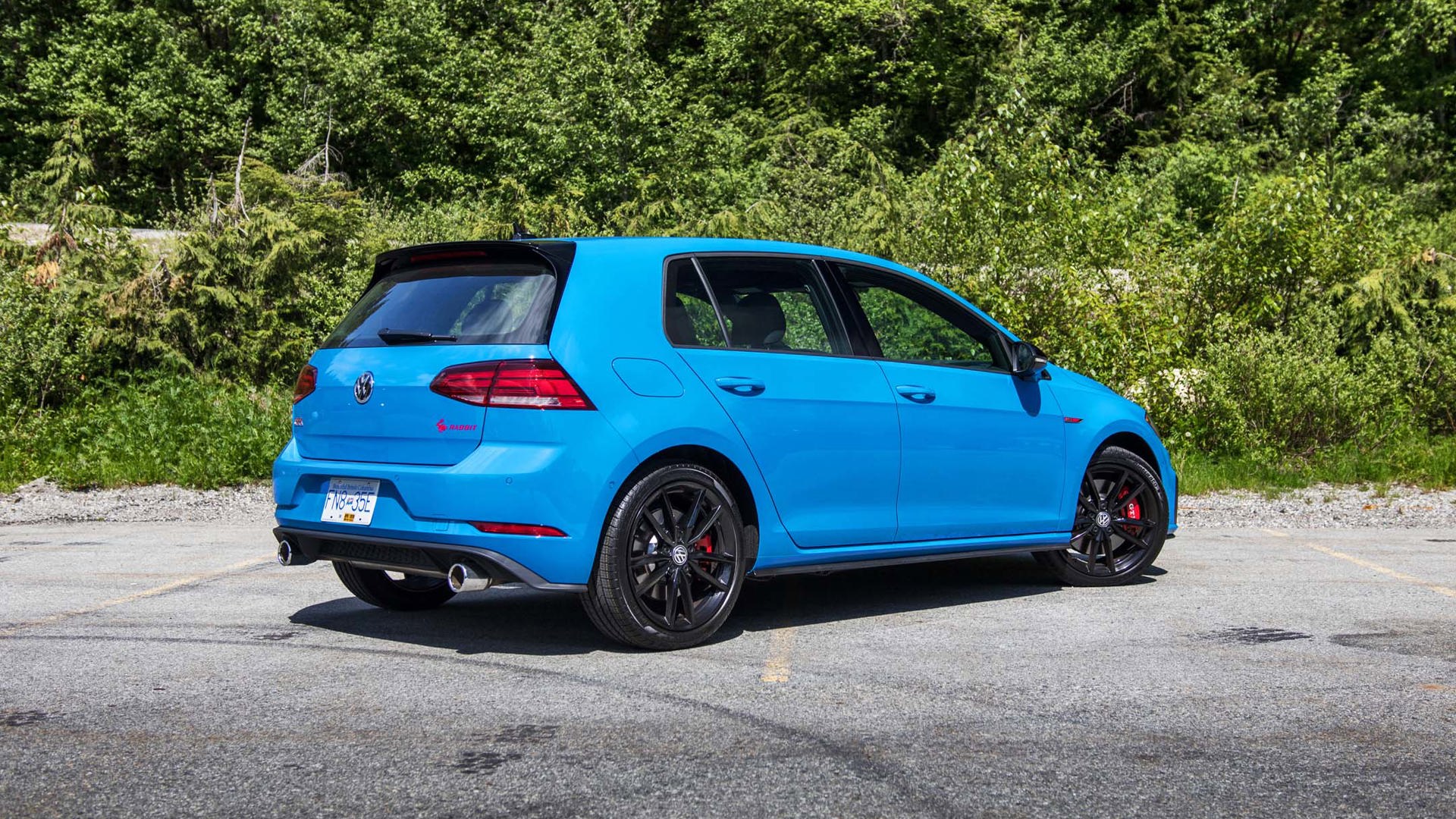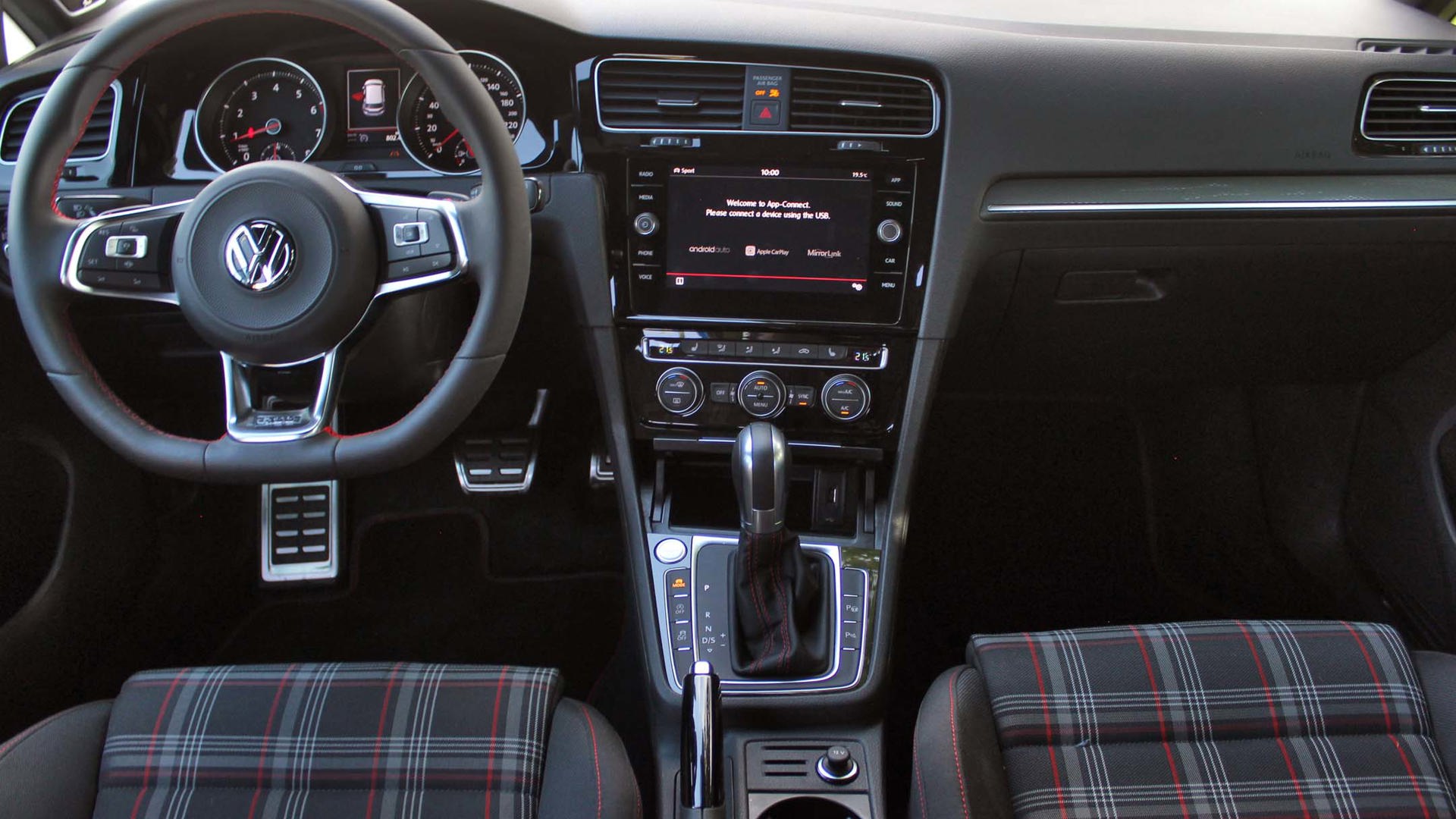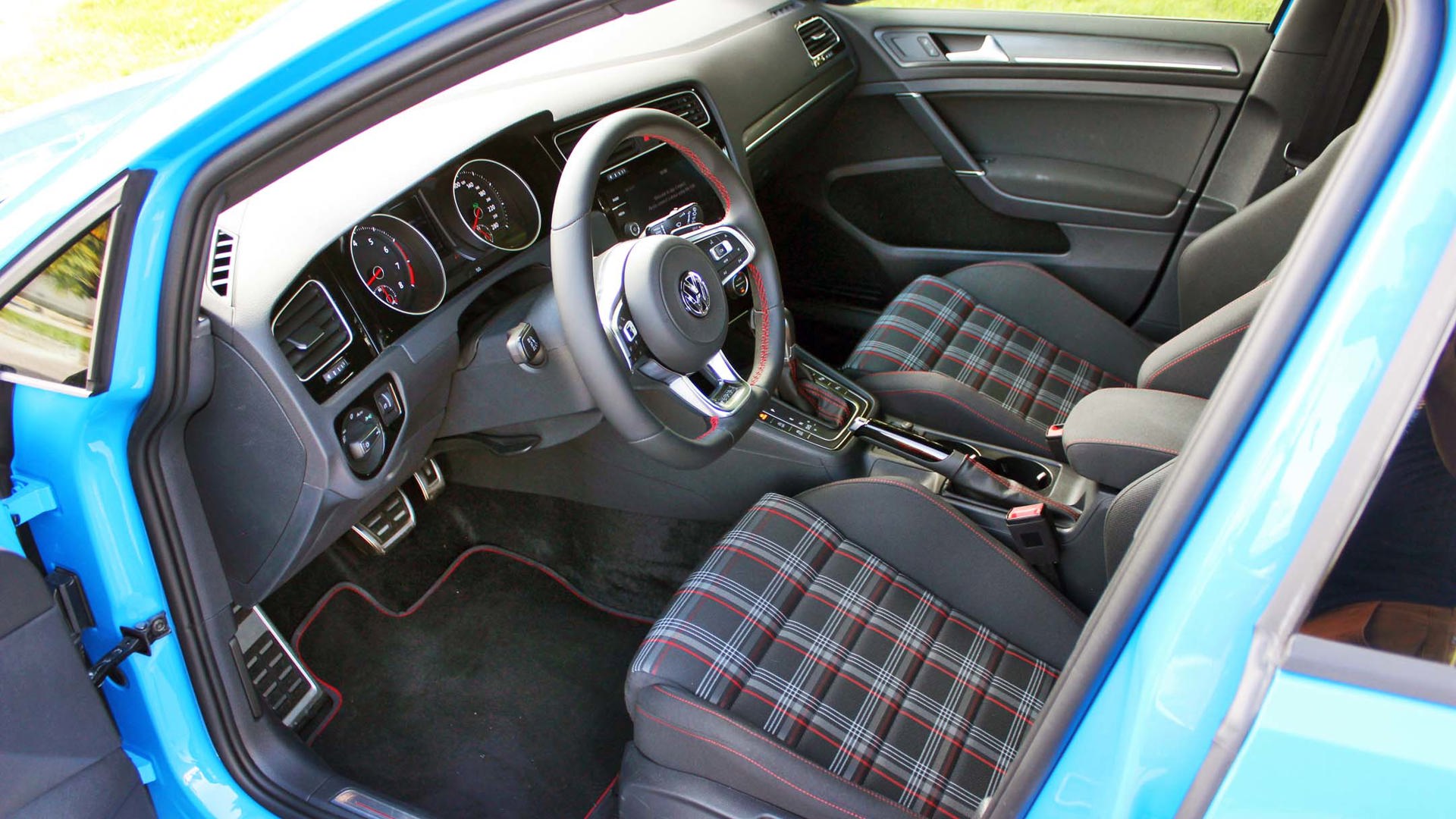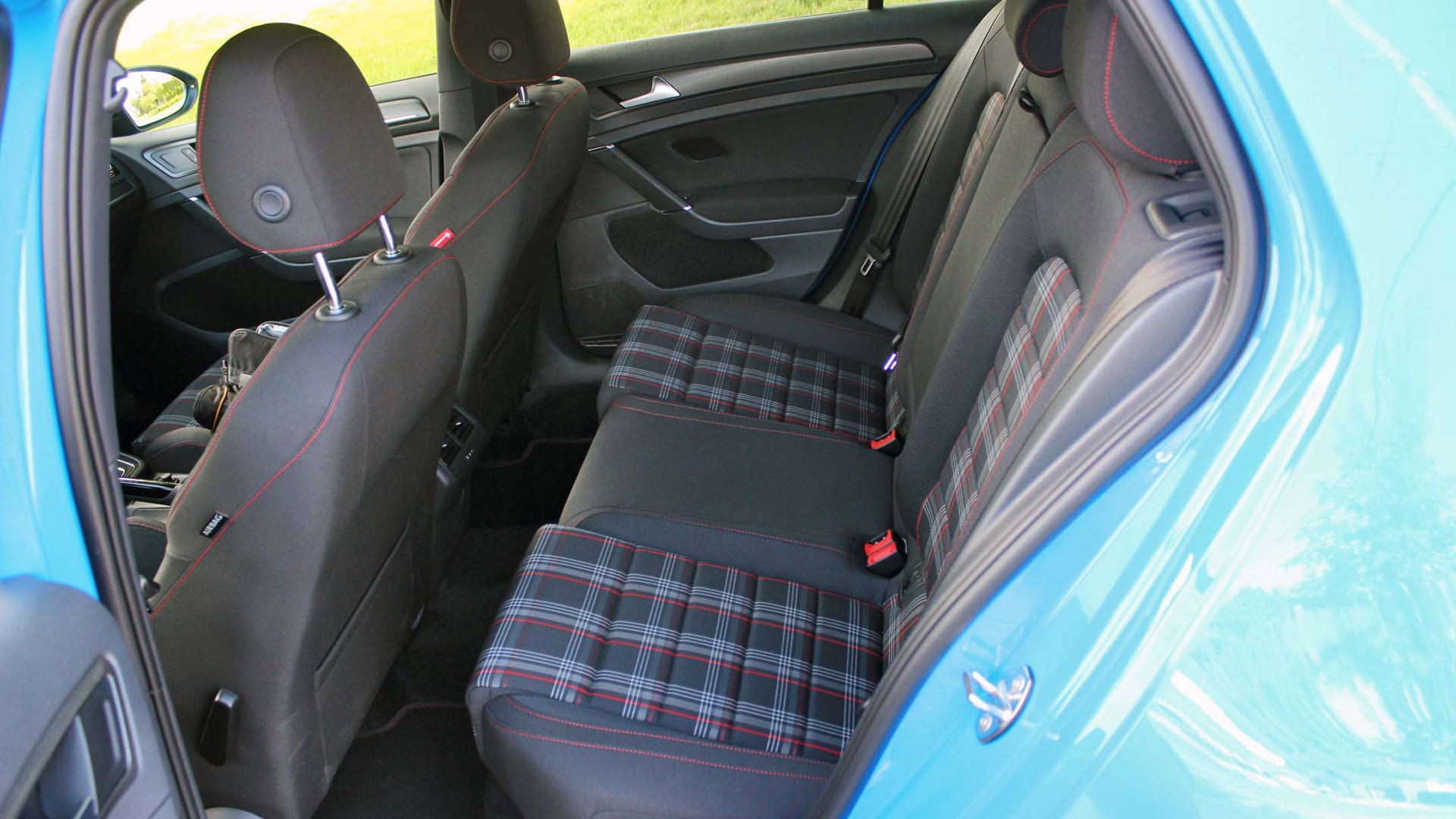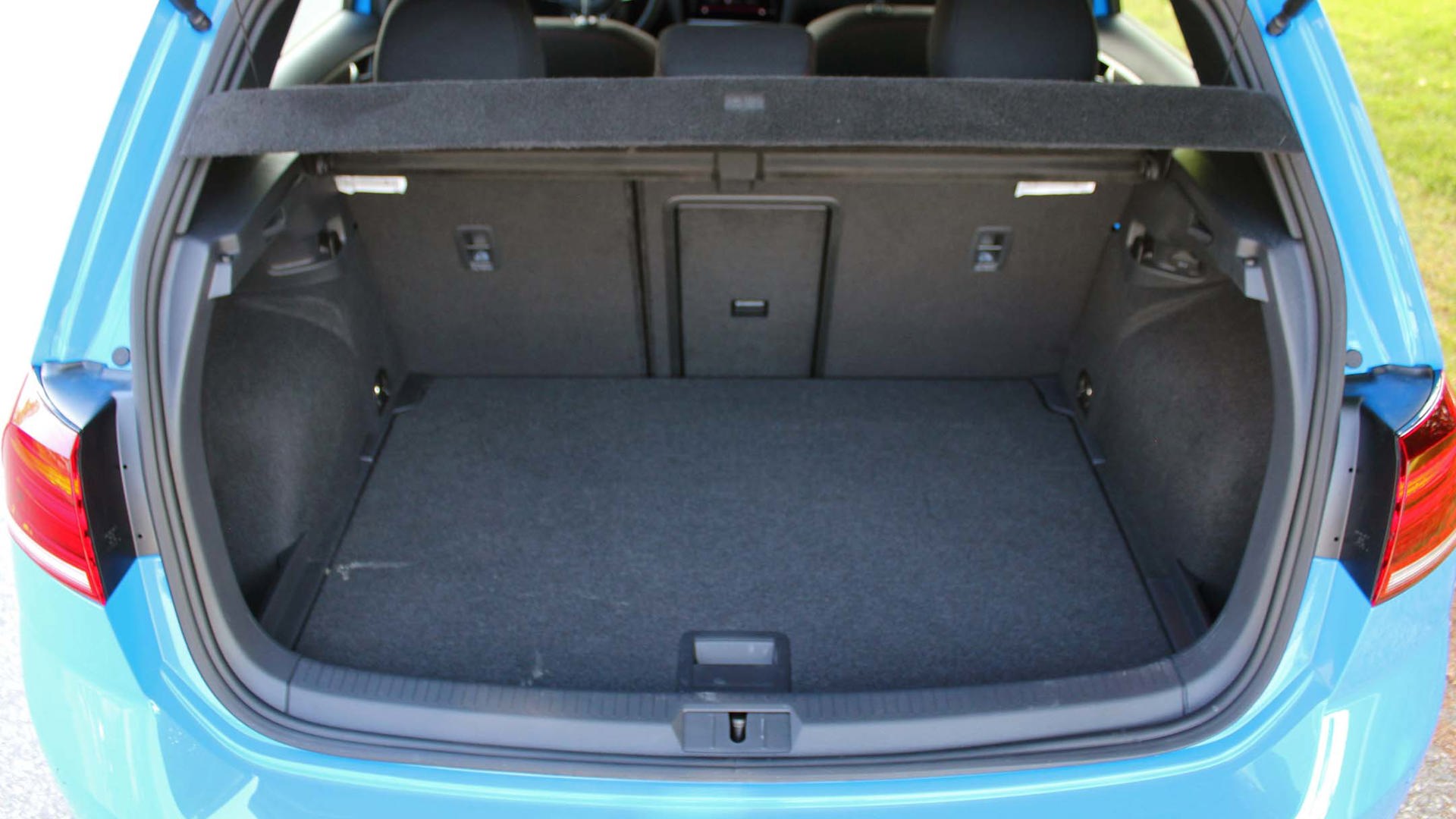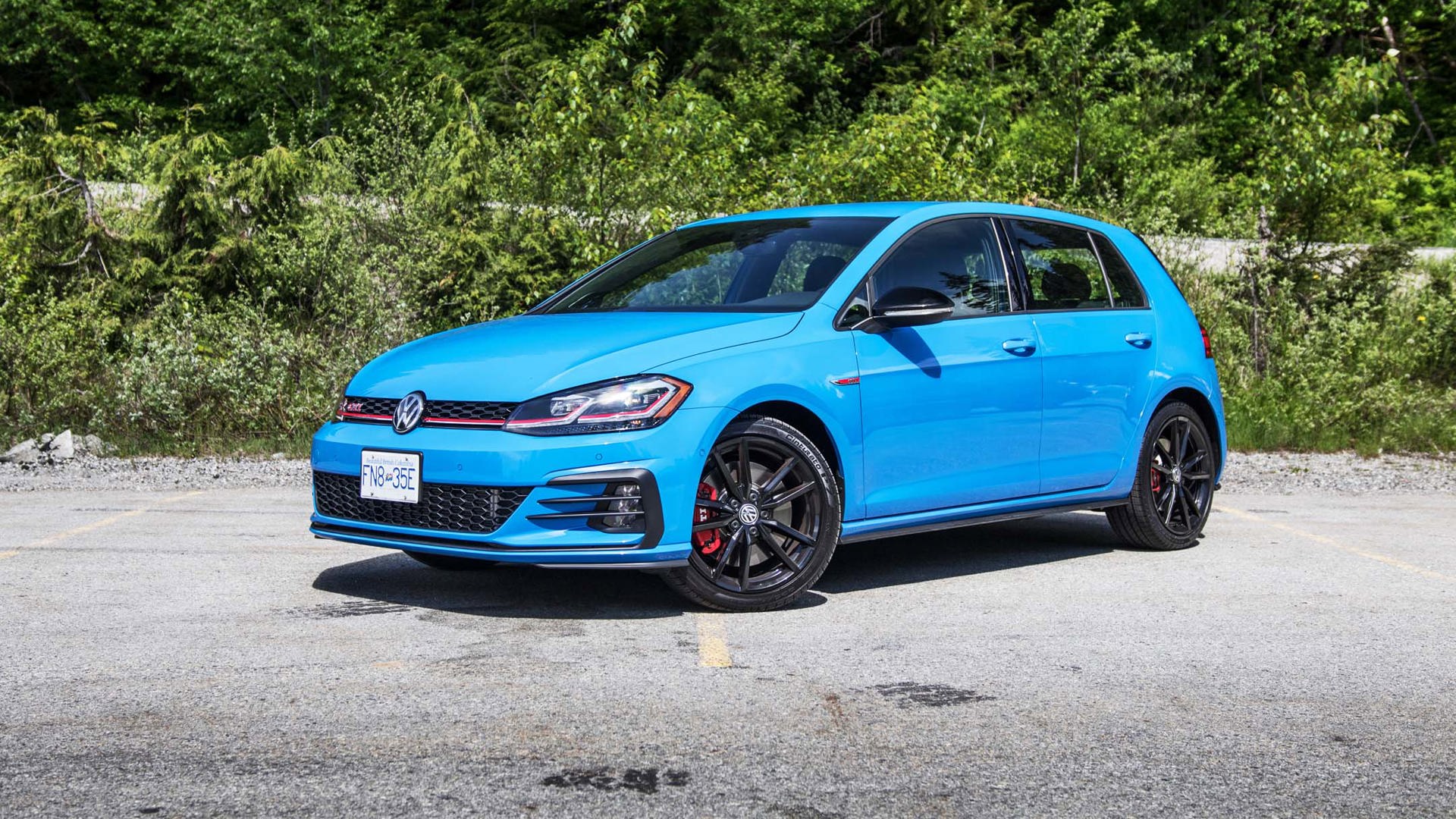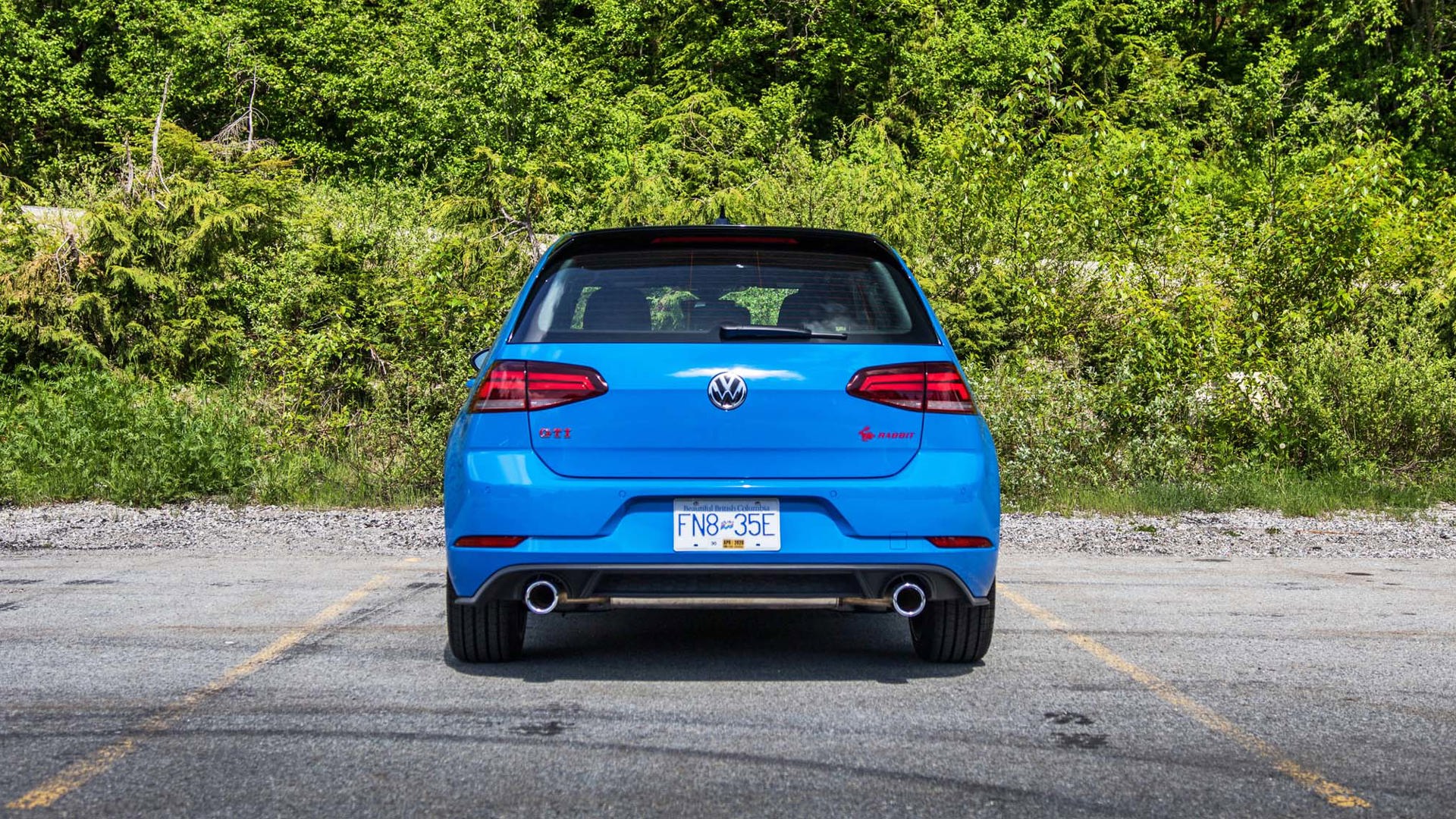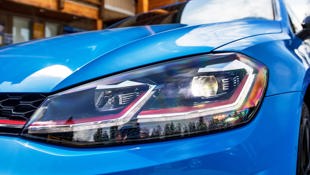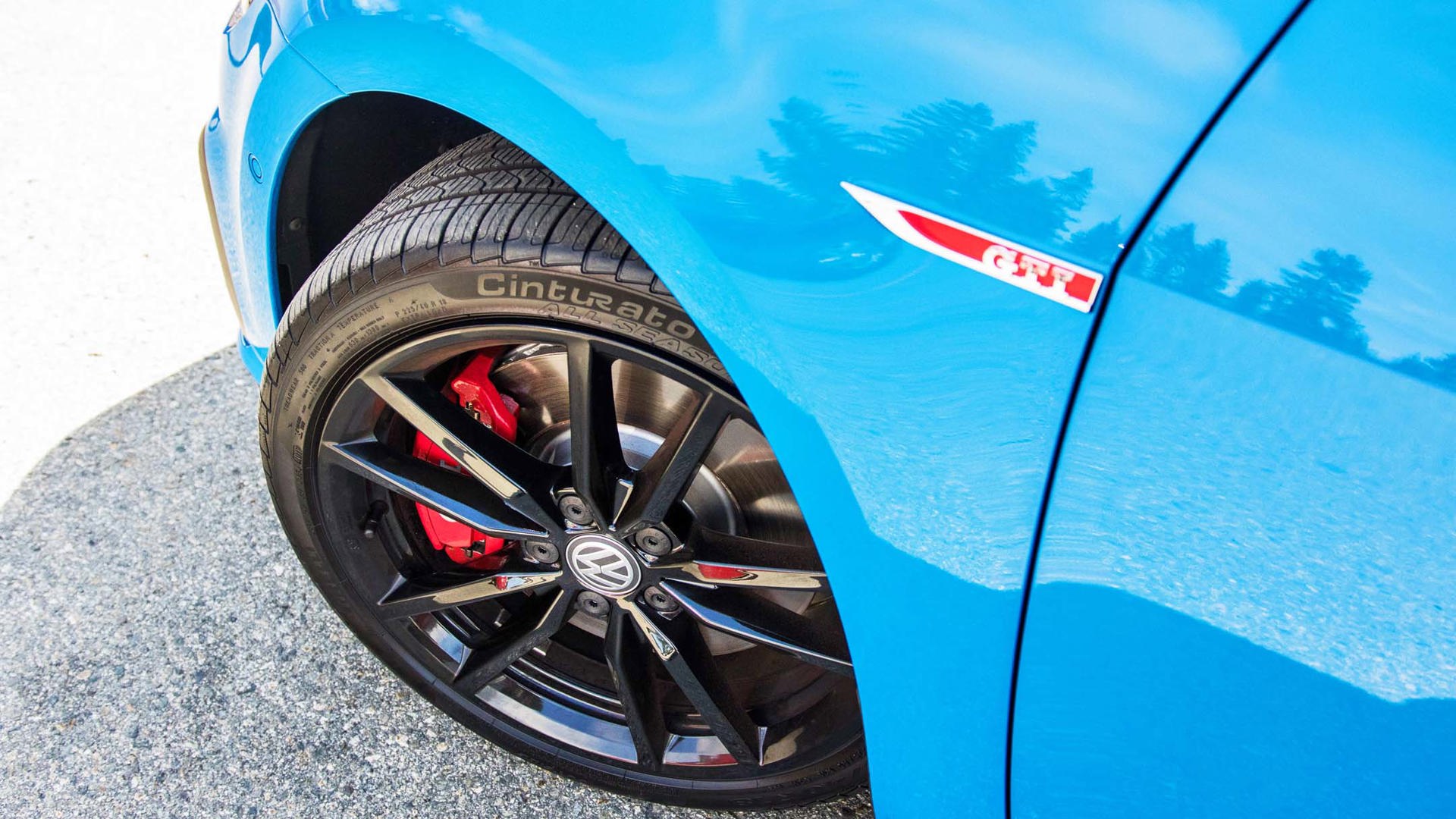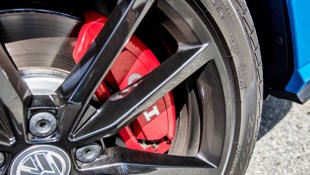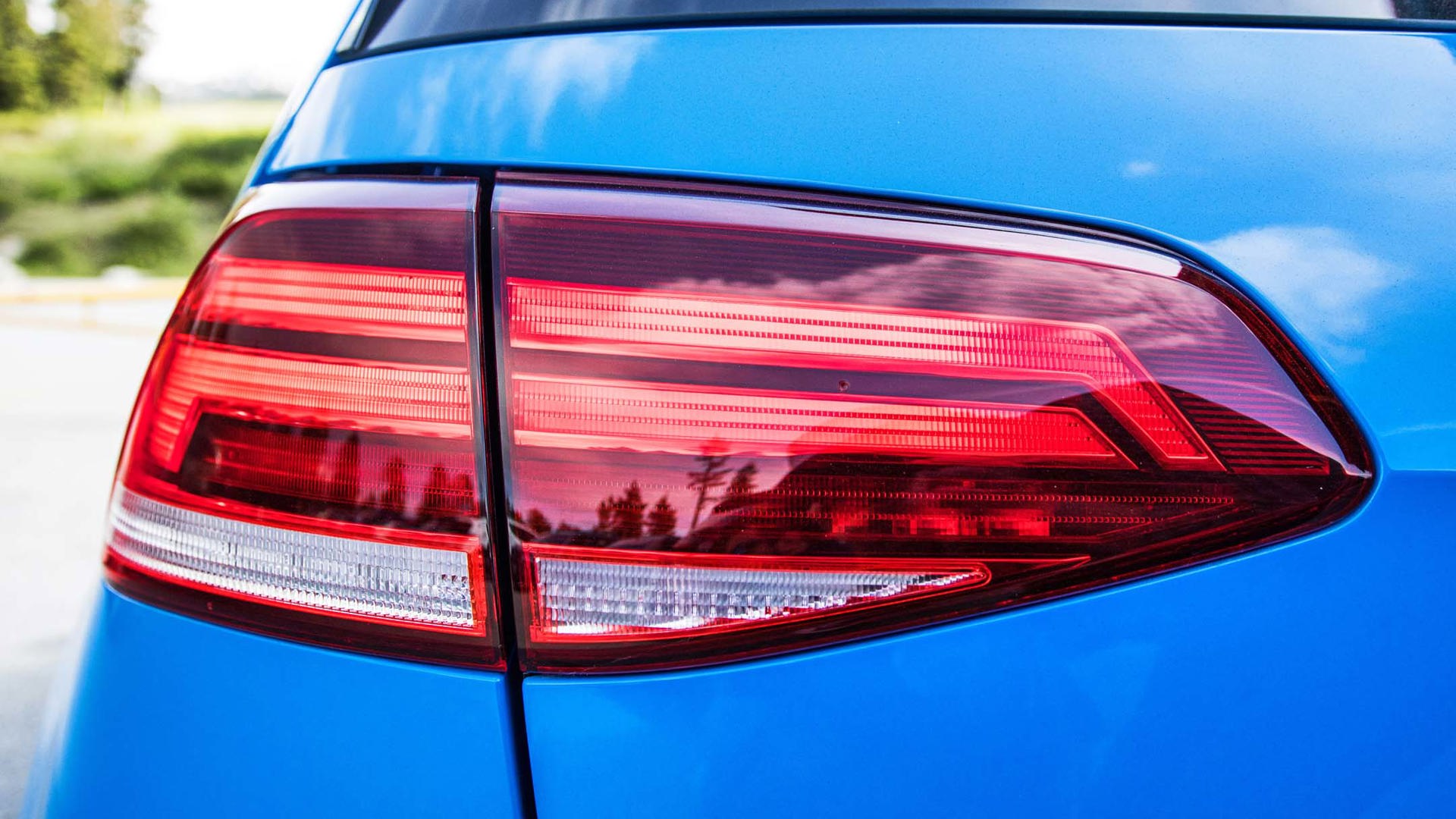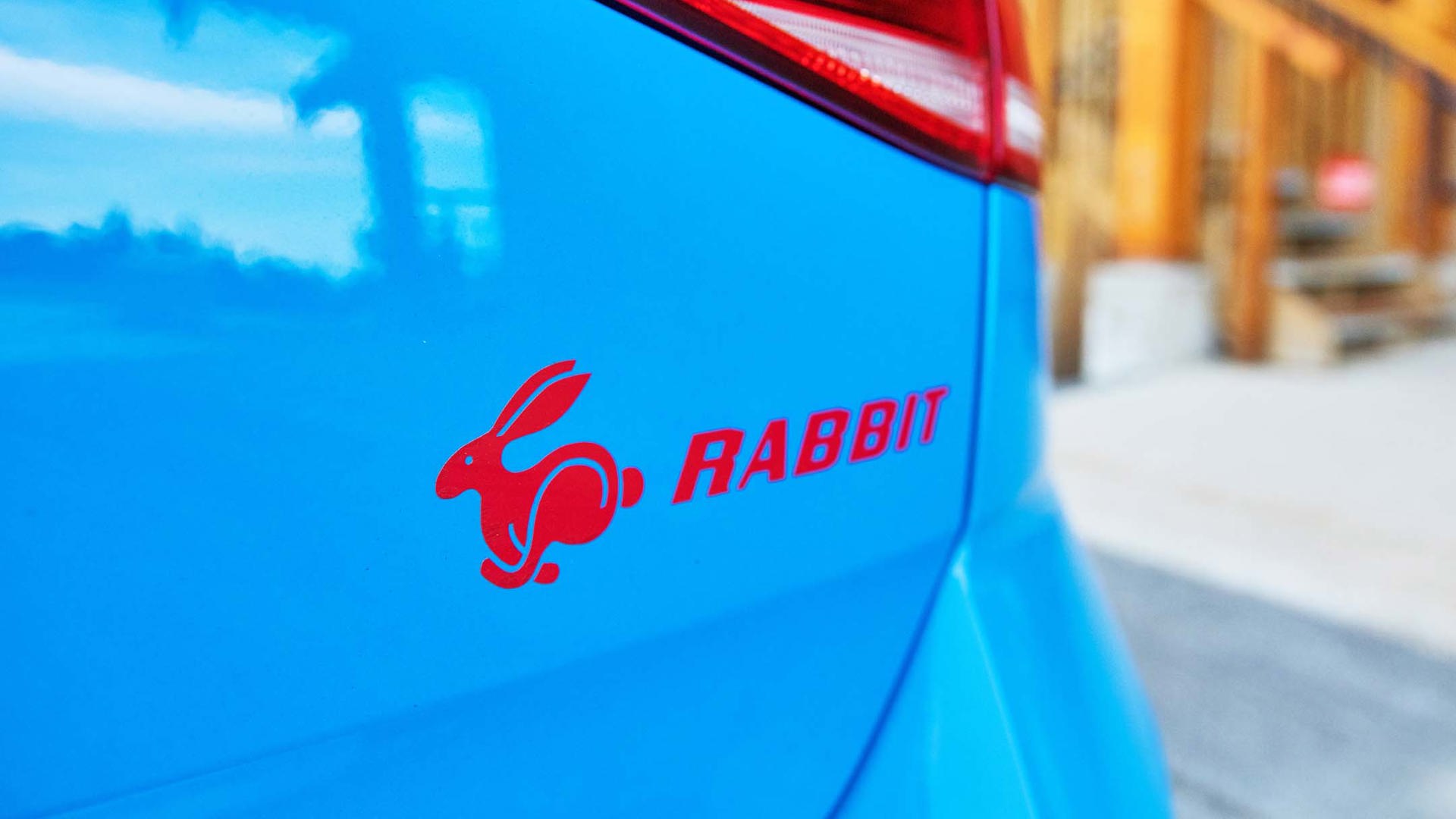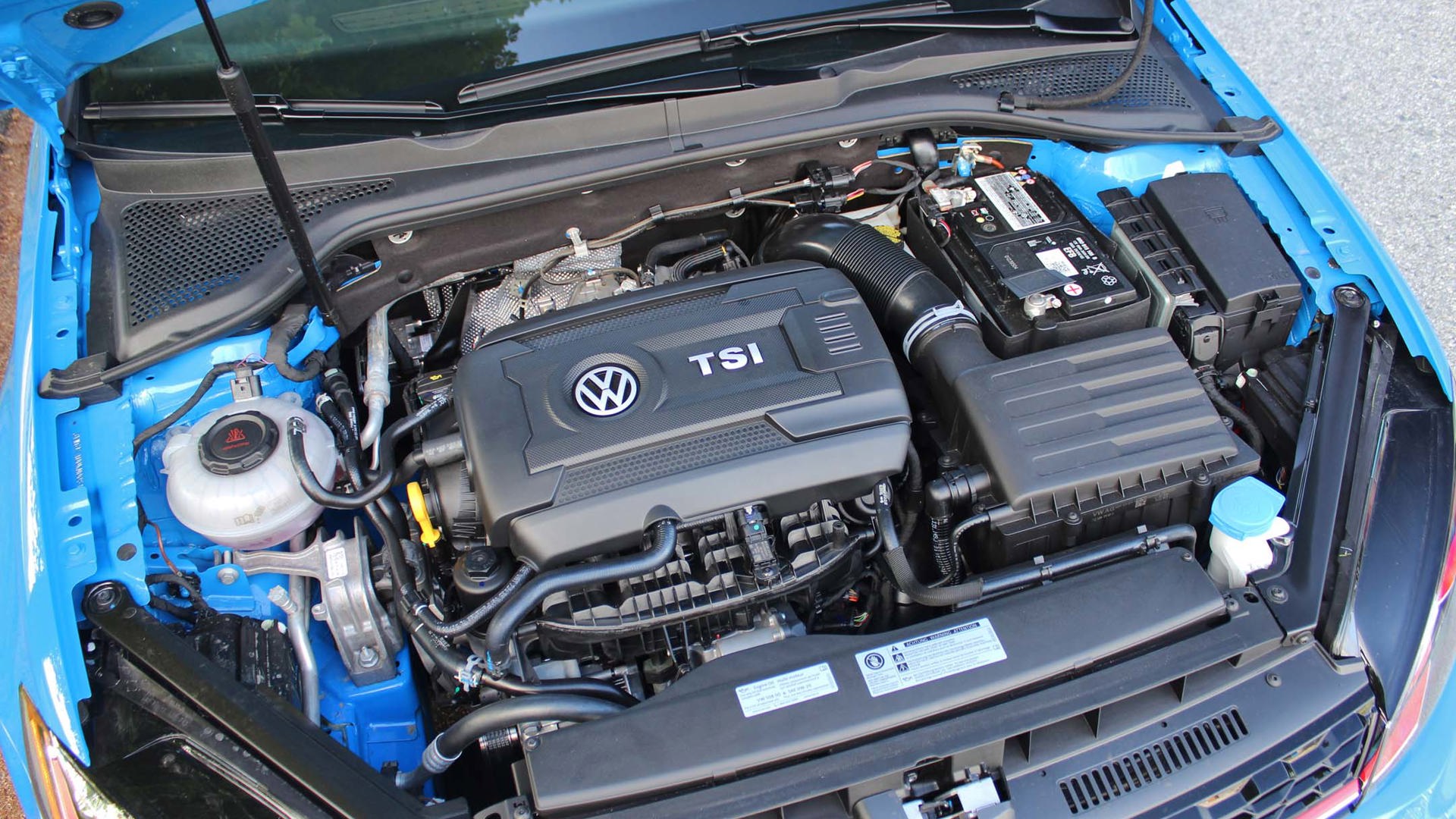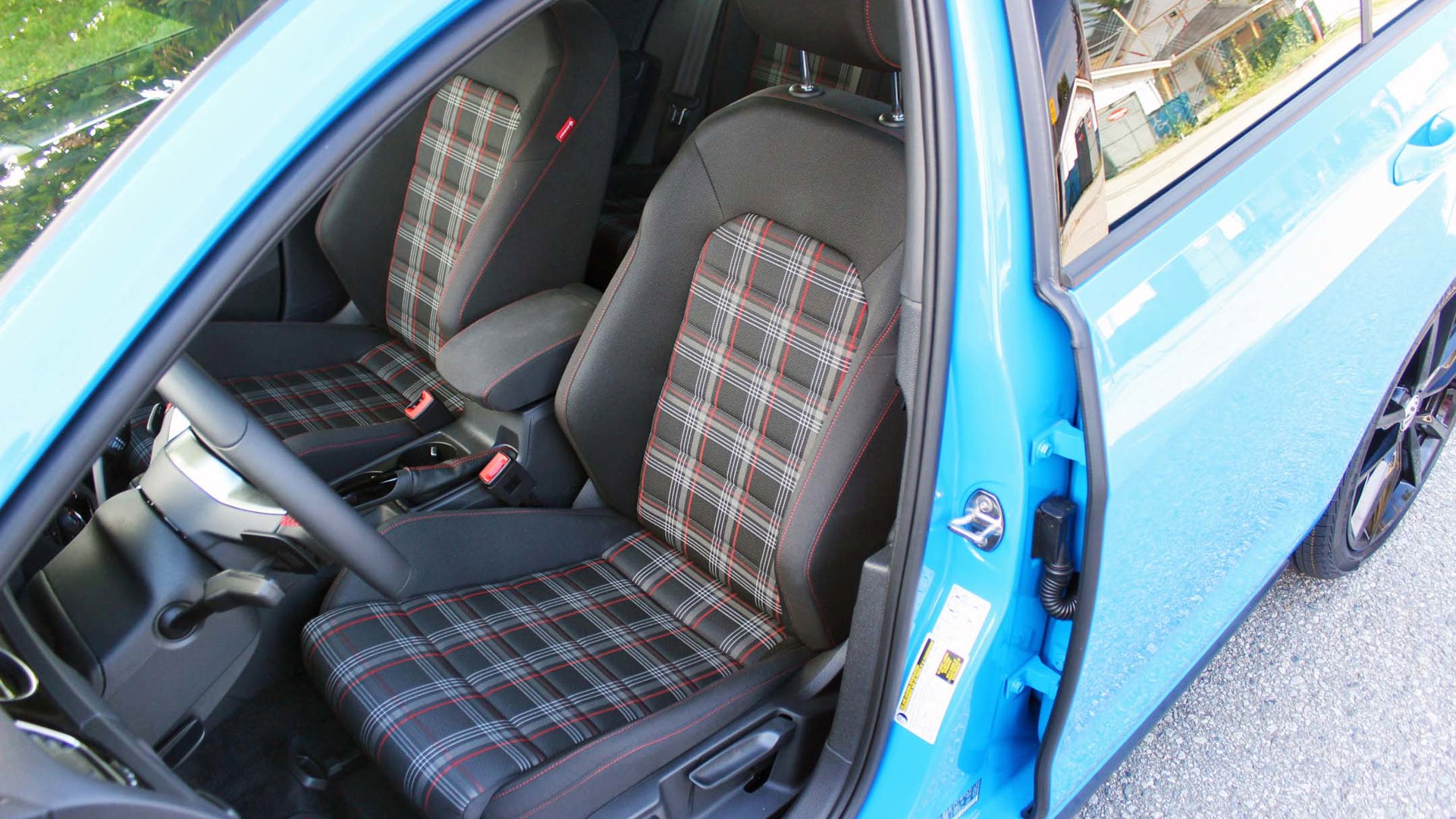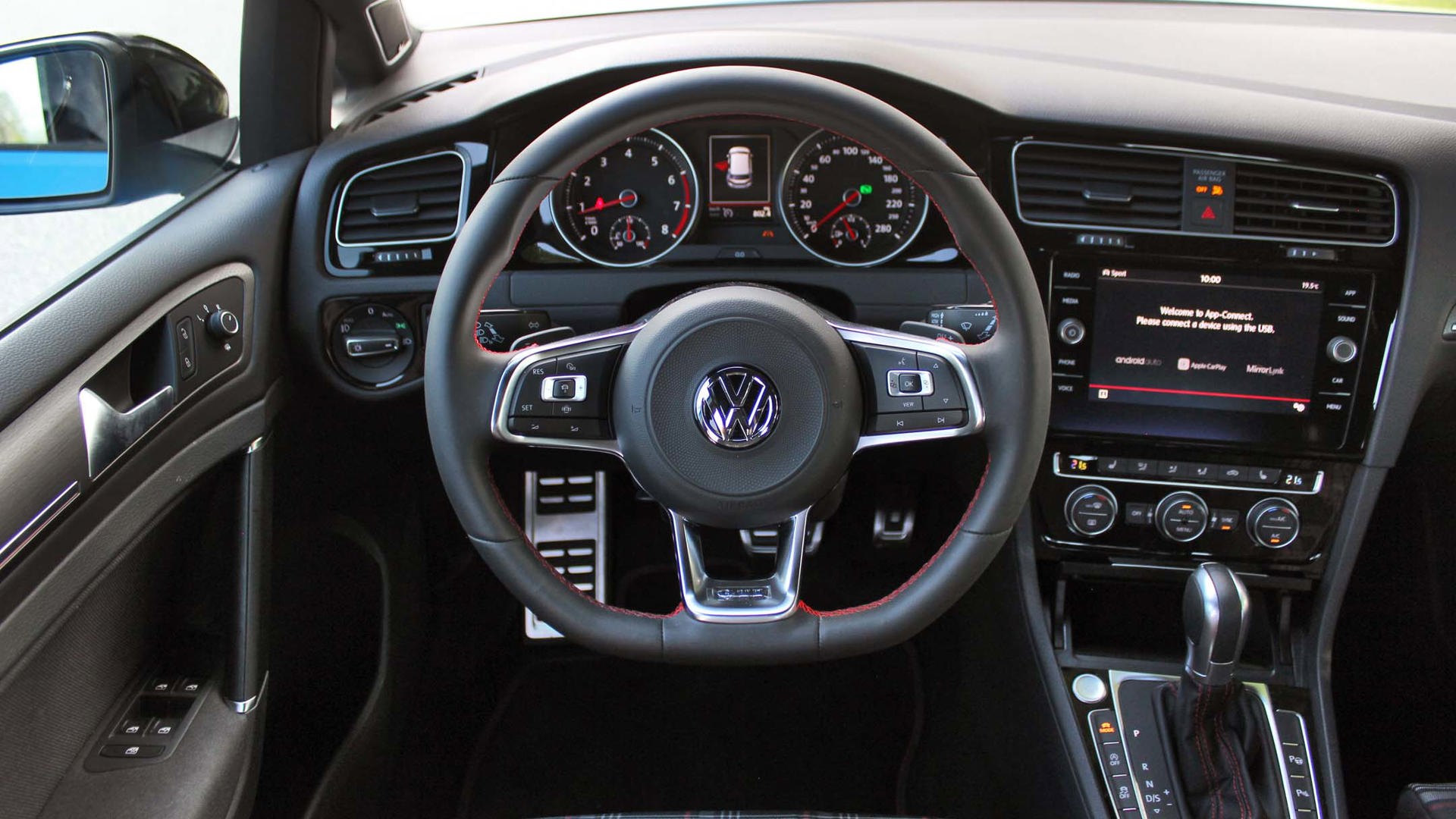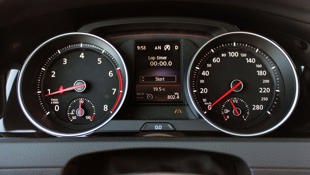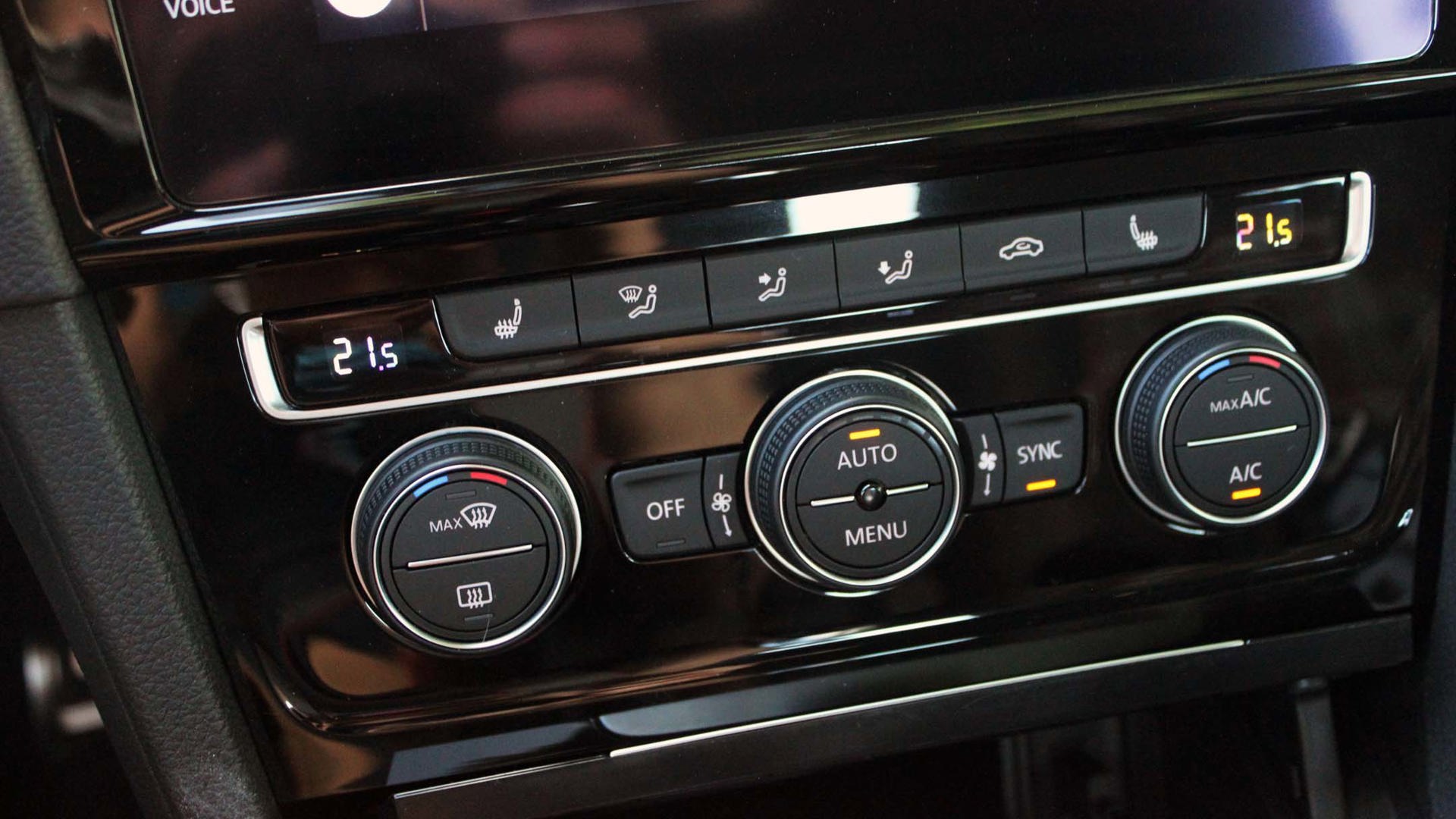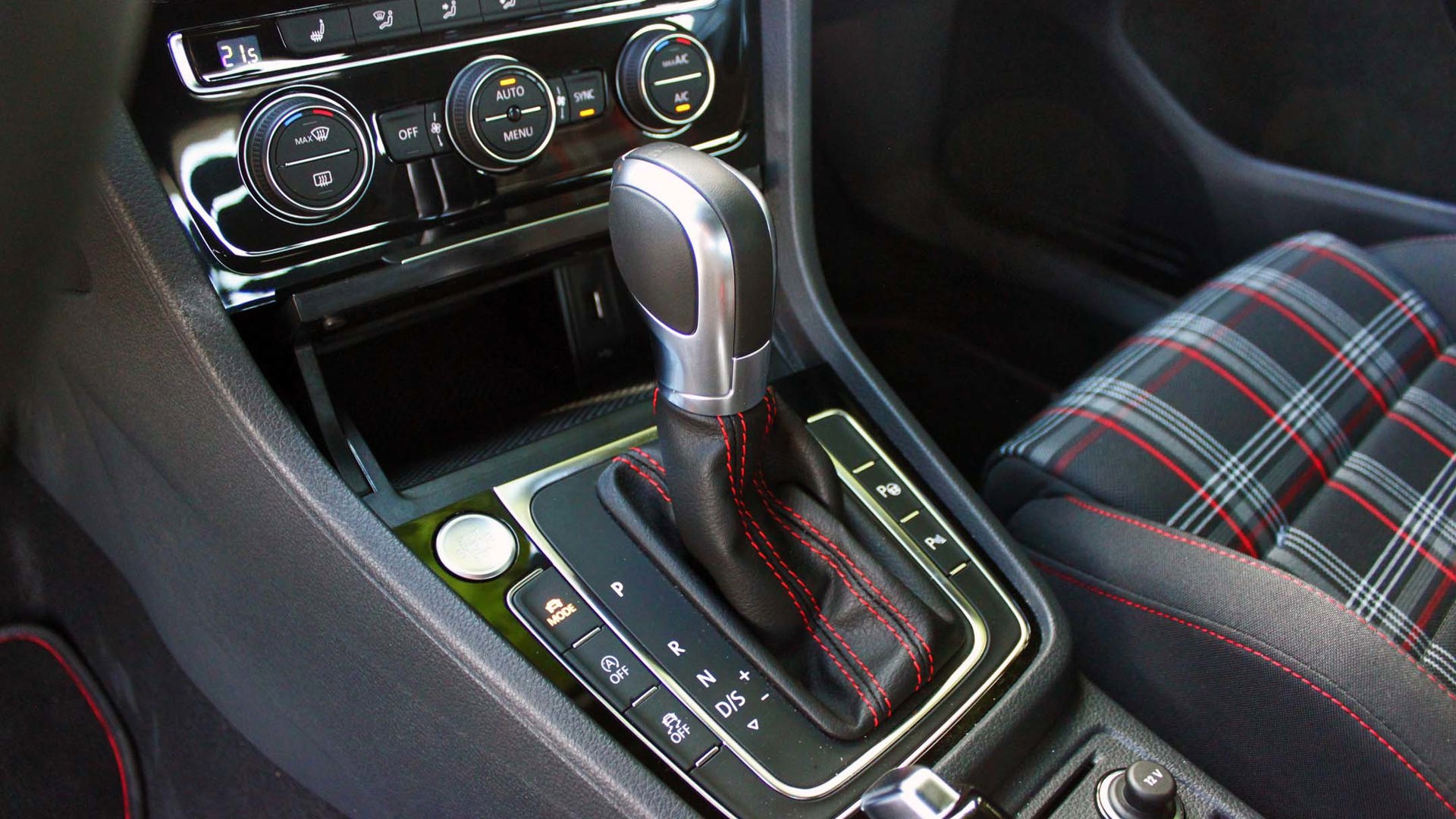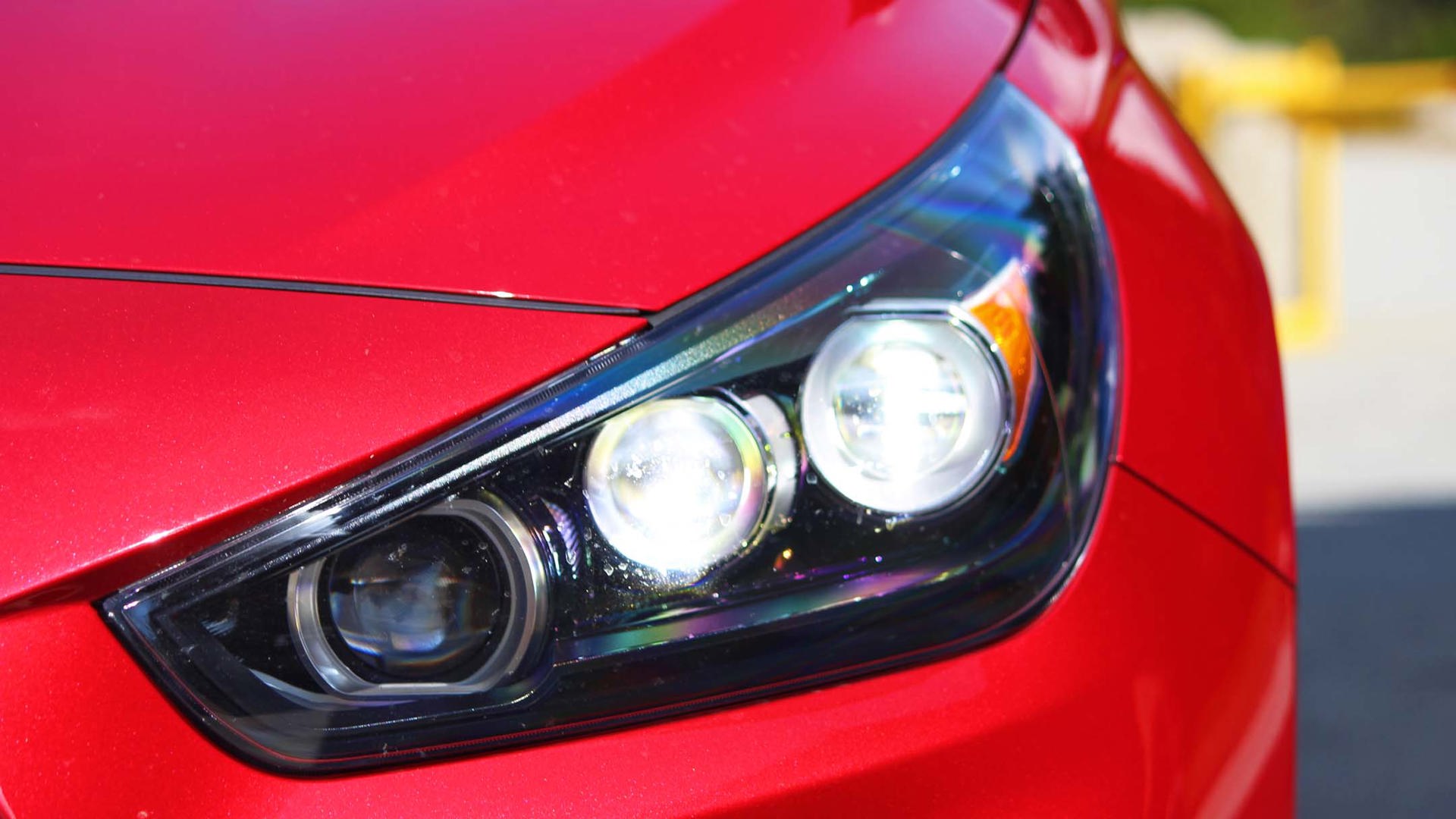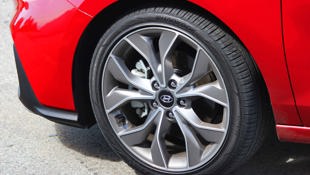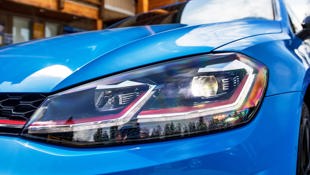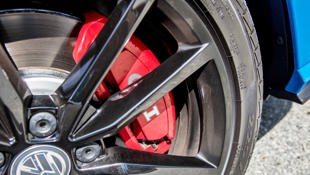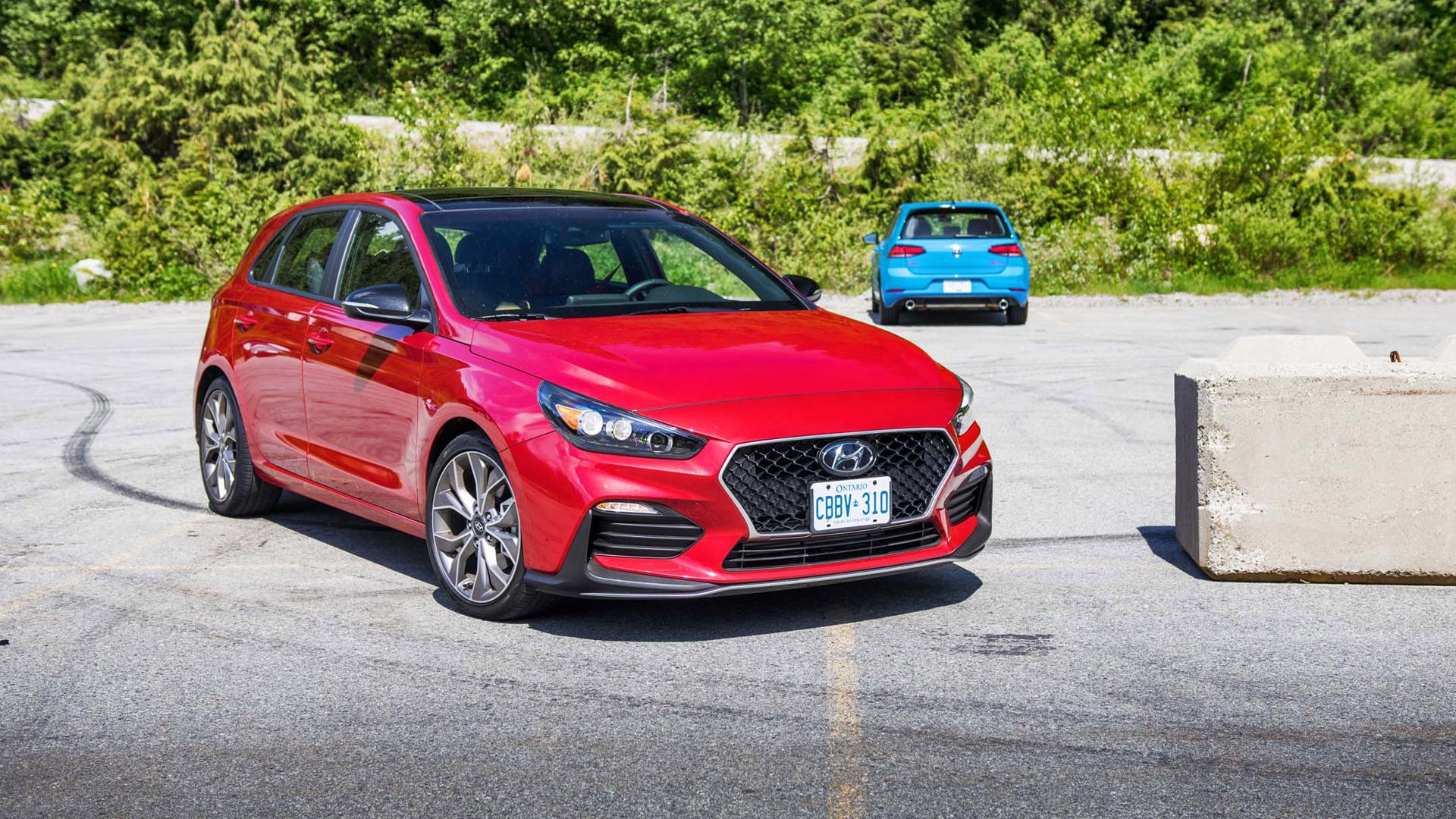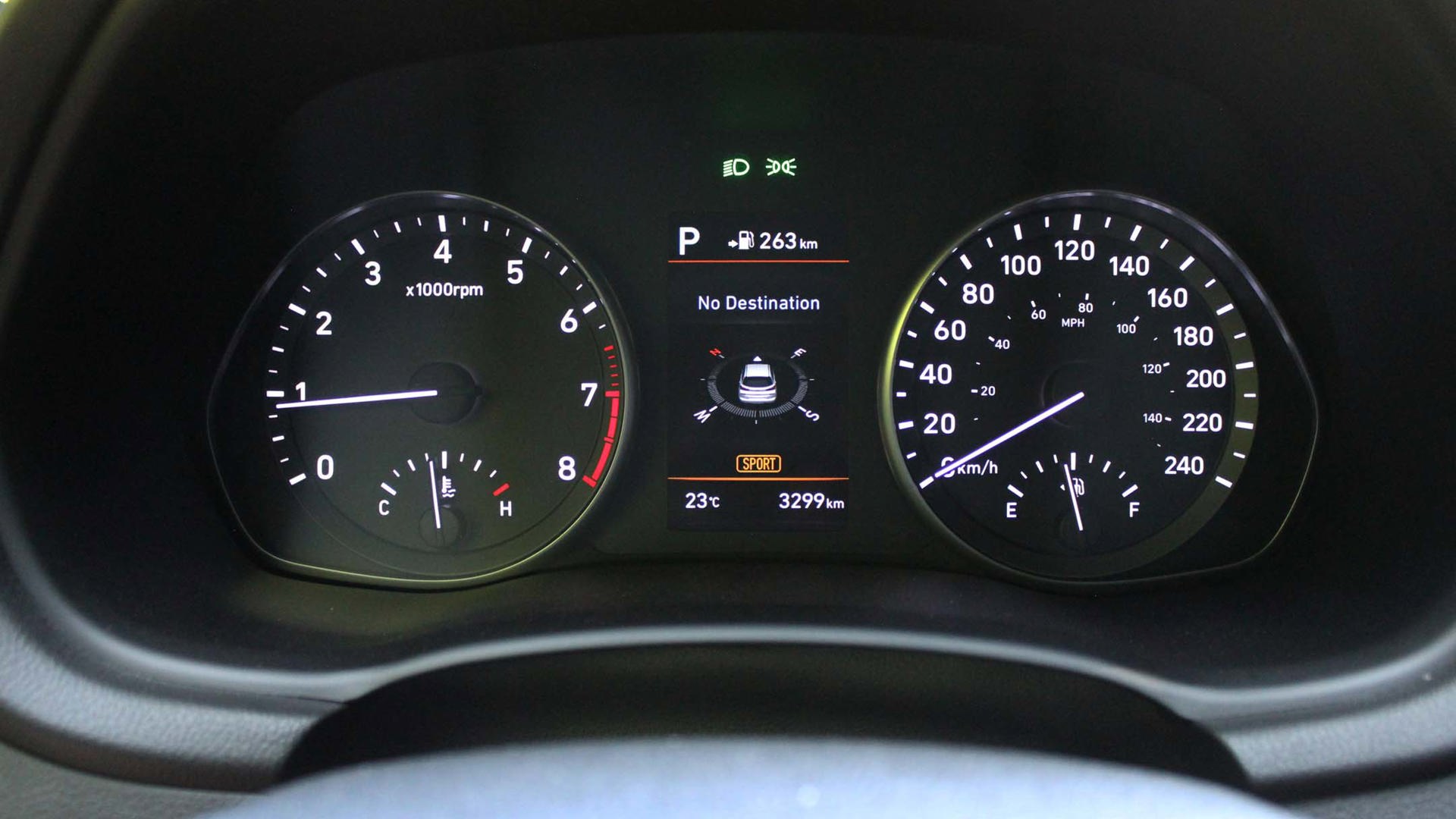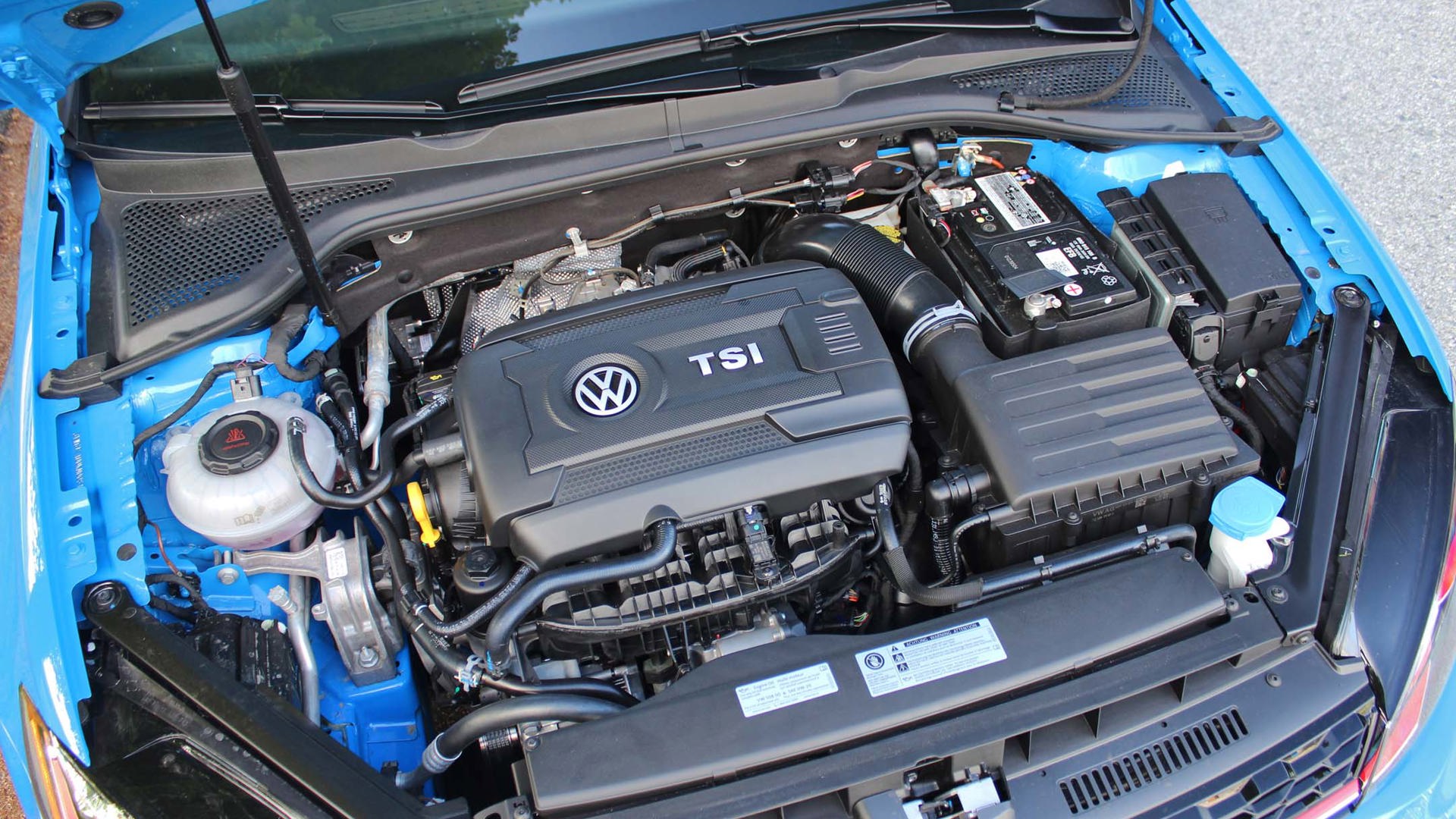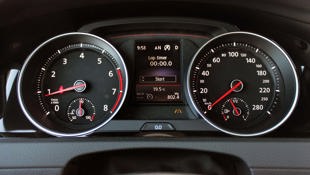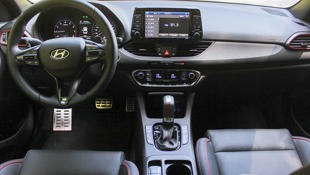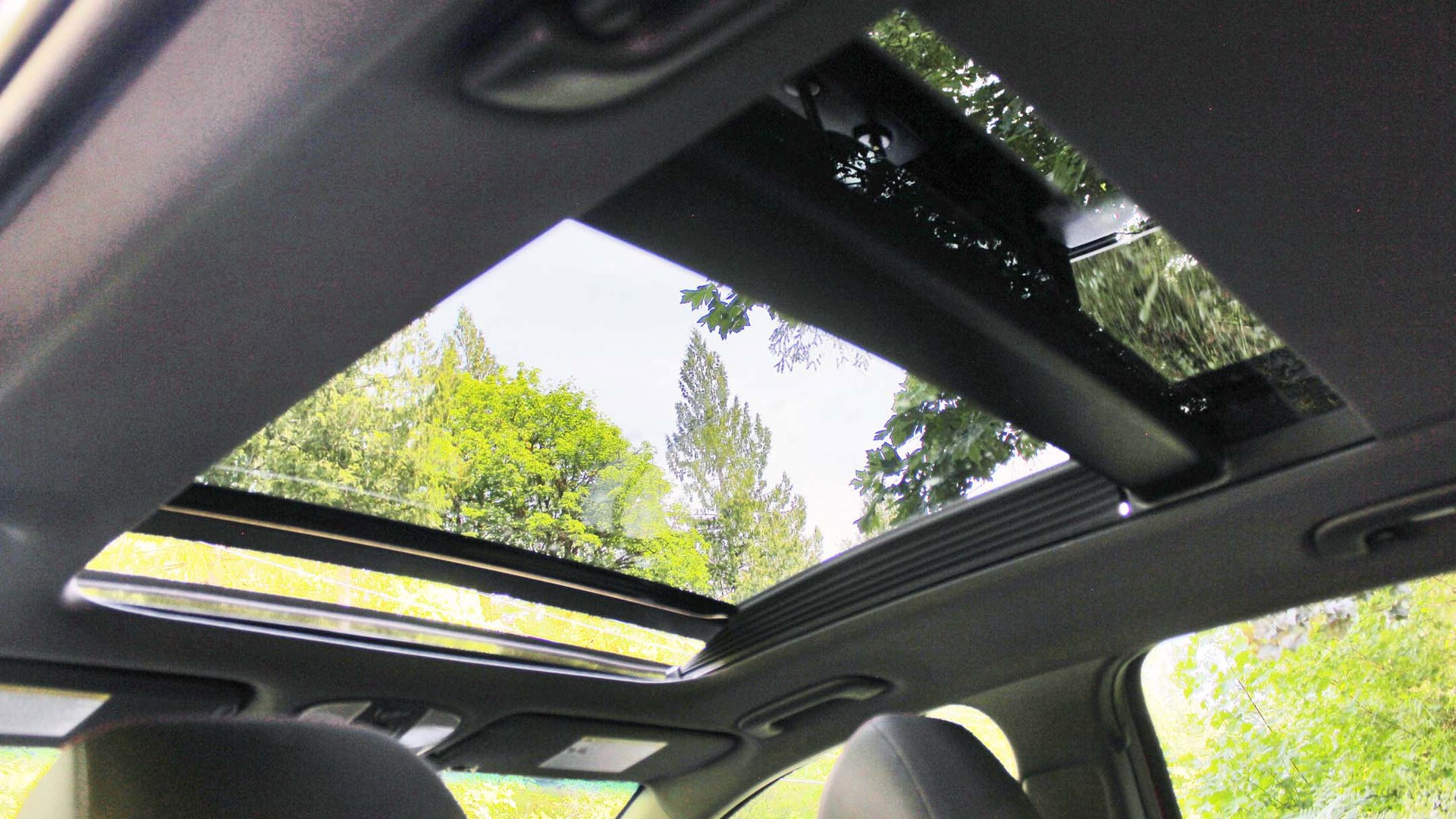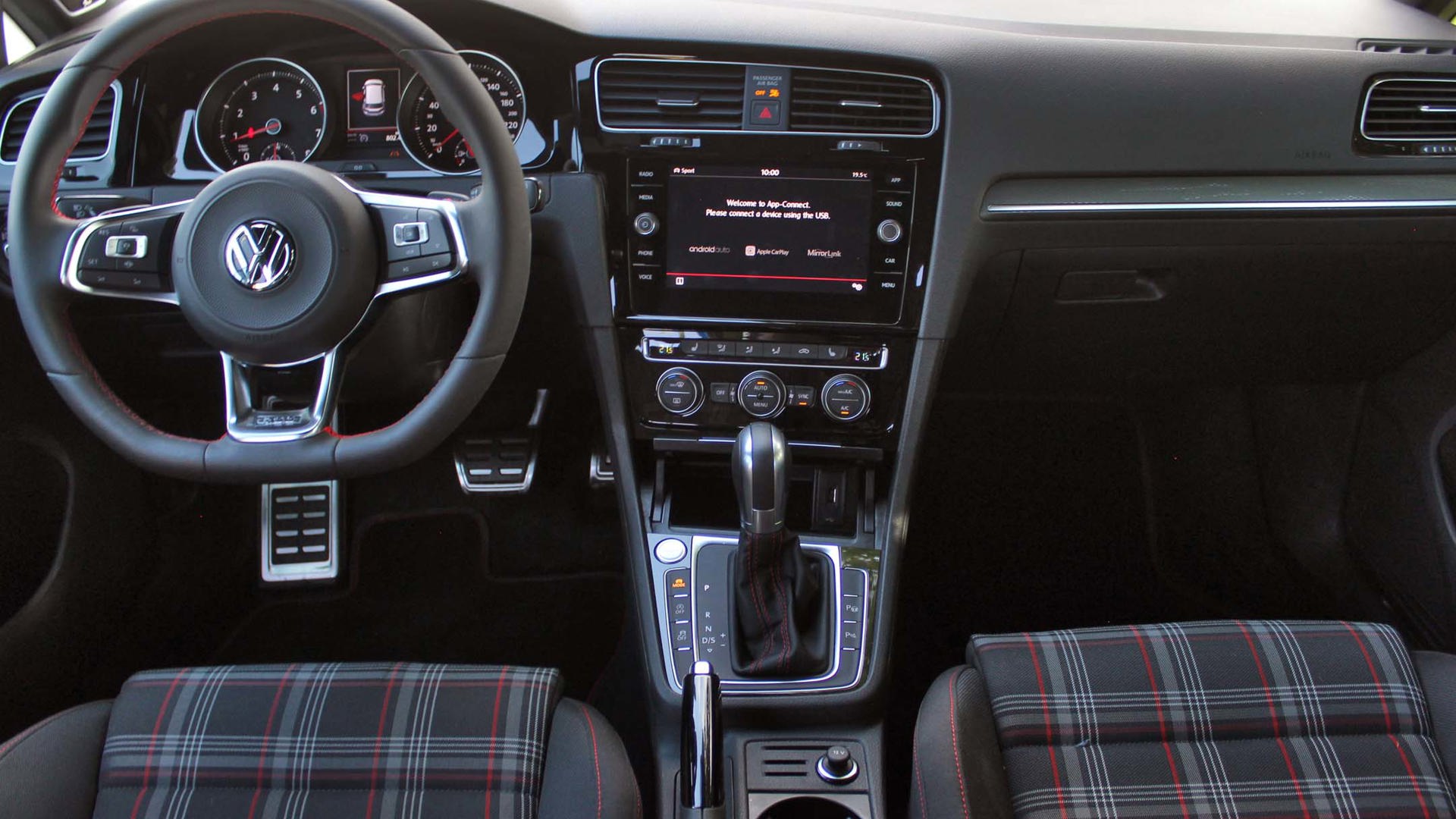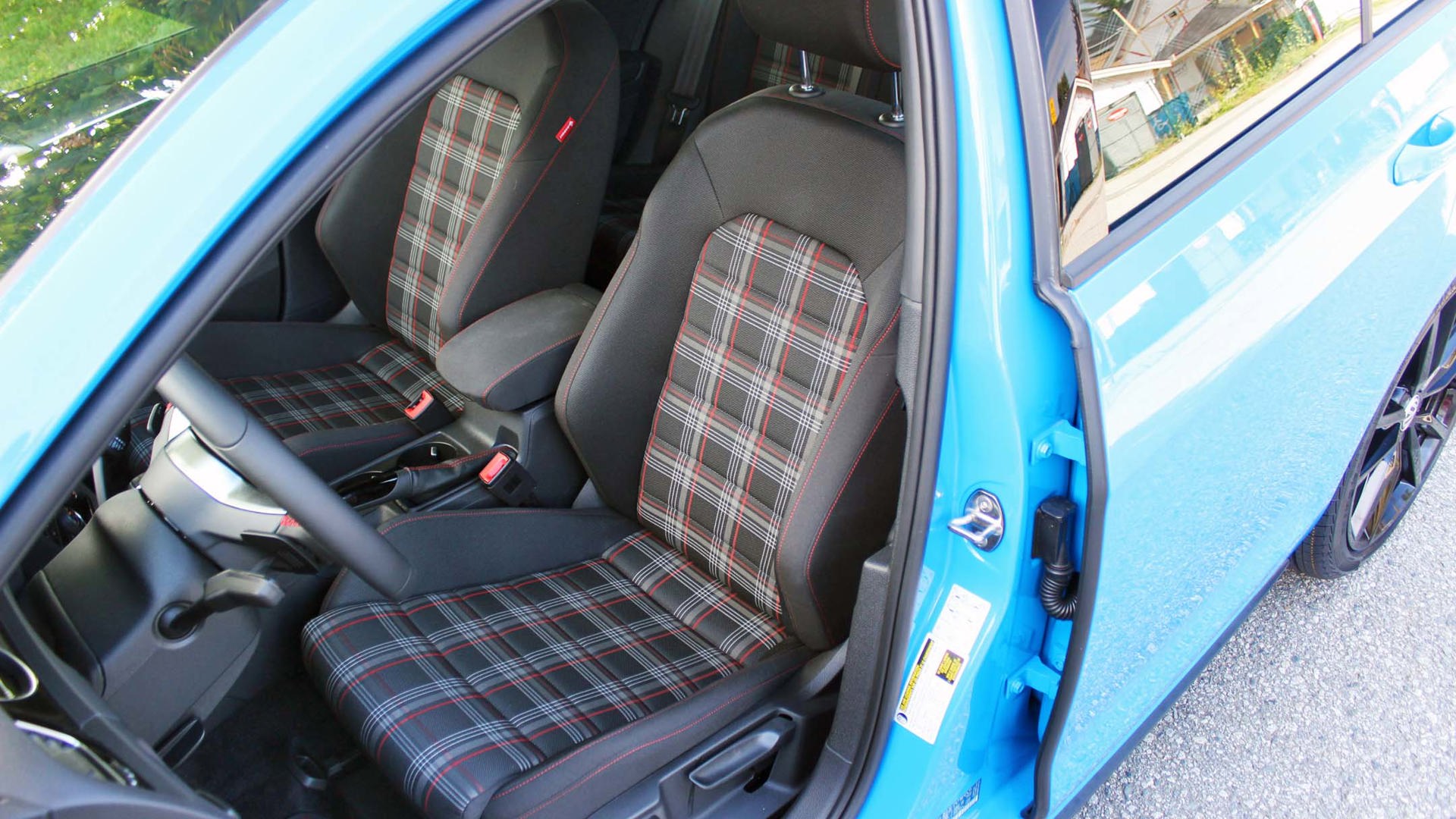Comparison Data
|
2019 Hyundai Elantra GT N-Line Ultimate
|
2019 Volkswagen Golf GTI Rabbit
|
|---|---|
|
Engine Displacement
1.6L
|
2.0L
|
|
Engine Cylinders
I4
|
I4
|
|
Peak Horsepower
201 hp @ 6,000 rpm
|
228 hp @ 4,500 rpm
|
|
Peak Torque
195 lb-ft @ 1,500 rpm
|
258 lb-ft @ 1,500 rpm
|
|
Fuel Economy
9.7/7.4/8.6 L/100 km cty/hwy/cmb
|
9.6/7.5/8.6 L/100 km cty/hwy/cmb
|
|
Cargo Space
705 L
|
493 / 1,521 L seats down
|
|
Base Price
$27,199
|
$33,995
|
|
A/C Tax
$100
|
$100
|
|
Destination Fee
$1,705
|
$1,645
|
|
Price as Tested
$32,704
|
$38,890
|
|
Optional Equipment
$3,700 – Paint $200; Ultimate Pkg (heated/ventilated seats, adaptive cruise control, seven-speaker stereo) $3,500
|
$3,150 – Seven-speed dual-clutch automatic $1,400; Driver Assistance Package Plus (adaptive cruise control with stop & go, blind spot detection with rear traffic alert and lane assist, front assist w/autonomous emergency braking, light assist, park assist) $1,750
|
Review and photography by Dan Heyman and Brendan McAleer
We’re not talking Rabbit and Turtle here.
Dan says:
The Volkswagen GTI must be tired. It’s a car many credit with being the originator of the performance compact hatch – way back in its original Rabbit days (in Canada, anyway) – which has become a popular segment, which means many manufacturers have dipped their toe in that pond, which means the GTI has had to do its best to keep its spot on the throne.
From the Honda Civic Si to the Mazdaspeed3, they’ve come from all corners of the earth. And now, here’s another challenger; this one’s from Korea, and is kind of an originator in itself. That’s because this competitor to the hot-hatch throne – the Hyundai Elantra GT N Line – is the first vehicle available in Canada from Hyundai’s performance-lite branch.
Brendan says:
I can hear the Germans chortling in Wolfsburg all the way over here. A Hyundai taking a shot at the GTI? Preposterous. The GTI is so well-loved it even has its own festival – the Wörthersee Treffen – filled with VeeDub fanatics and modified cars. Hyundai might have gained in leaps and bounds in terms of value for your dollar, but this is a performance icon we’re talking about.
Having said that, the turbocharged versions of the Elantra were really eye-widening when pitched up against the Civic Si, another hot compact hero. With this new N Line version, the Koreans are looking to show that they’re not willing to just be the value brand on the scene. They’re coming for the king. Let the game of plaid thrones commence.
Styling
Dan says:
Traditionally, I’d say that the GTI – while very quick and agile – has never really shouted about it styling-wise. Previously, you’d have to look pretty closely to differentiate the GTI from “lesser” Golfs (and the same can be said between the GTI and its upmarket Golf R sibling): the red band around the grille, special wheels, and maybe some body add-ons here and there, perhaps the traditional tartan cloth seats inside. It wasn’t hard to nip and tuck your Golf TDI and make it look somewhat GTI-ish; in fact not long after I returned the Golf, I saw a TDI hatch that fooled even me.
The same can’t be said for our tester, however. You see, the Rabbit name has returned once again, and it adds a bunch of cool stylistic touches that ensure that no one will mistake it for something more garden-variety. It doesn’t go much past special 18-inch black alloy wheels and colouring (“cornflower” blue), but those details alone make this look like one special, handsome Golf. Inside, the tartan seating (with “Rabbit” tags!) is standard. It’s fantastic to take in, and try as the Elantra GT does, the GTI was the head-turner of the two.
It’s not that the Elantra is bad; I’m a fan of the metallic red paint and 18-inch wheels but even though N Line spec adds cool stuff like a unique grille, rear bumper, black outside mirrors, and new front spoiler, it doesn’t move the needle as much from where the standard Elantra GT sits.
Brendan says:
As Dan points out, the GTI has a distinct advantage here because it’s building on the standard Golf. The GTI doesn’t need much in the way of upgrading over the standard car, as it’s supposed to be a bit reserved anyway – ideally, a GTI should be able to lurk in the car park at your work without letting your boss know that you’re a fan of ripping up a backroad on the weekend. Obviously our tester’s bright blue paint is a bit of a giveaway, but it’s still technically a sleeper.
On the other hand, the Elantra is also based on a pretty good car. The hatchback variant of the Elantra is better-looking than the sedan, especially with the latter’s facelift for 2019, and compared to Japanese rivals, it’s a very clean design. The Golf may be the classic look, but the Elantra’s tribute to it is imitation-as-flattery.
Then, add the N Line’s expected visual upgrades, and you’ve got a very tidy package indeed. I’m going to rate this one as a tie.
Interior
Brendan says:
The GTI leans on its heritage here with those plaid seats, and with a spartan interior that’s distinctly German. Really, Hyundai doesn’t have much of a chance here as it’s writing its own playbook from scratch, with red trim here and there on the seats and around the vents.
Put simply, the GTI feels more special than the Elantra. Yes, the tartan seats are maybe a cliché, but they’re a cliché that works. The GTI feels like a GTI; the Elantra feels like a hot Hyundai hatch. There’s a difference.
Dan says:
While the Rabbit does get neat-o stuff like the tartan seats, leather-wrapped wheel and 8-inch infotainment, the Elantra GT gets the more modern-looking – even more upscale, thanks to the leatherette seats – interior treatment. Where the GTI is all up-and-down right angles and square vents, the Elantra is big, flared surfaces, widescreen infotainment and pointy angles around the vents, centre stack and even steering wheel spokes. The two gauge displays are similar – both feature traditional two-dial analogue set-ups – but that’s kind of where the similarities end.
Infotainment
Dan says:
Since these are both cars aimed at a slightly younger audience, infotainment is an important part of the equation. Both feature 8-inch displays with Apple CarPlay and Android Auto as standard, with rich colours and responsive touchscreens. They both get that, but I’m going with the Elantra here as the graphics are cleaner, the menus a little more intuitive to use thanks to larger, more colourful buttons, and the menu options themselves are more easily accessible. Plus, the fonts and icons are just that much more modern, in keeping with the rest of the interior as a whole.
Brendan says:
Hyundai’s infotainment is a great deal more intuitive than VW’s, if a bit less flashy. The drive mode selection on the GTI has more options, and is a bit more special-feeling than the Elantra’s Eco/Sport/Normal settings. Again, this is one of those situations where the GTI feels like it’s doing a better job of being something apart from a normal hatchback. On the other hand, the Elantra is sensibly set up for everyday life. But let’s get to the good stuff.
Driving
Dan says:
With cars like this, the drive is really what separates the wheat from the chaff. You can spend all the time you want on infotainment and snappy colours, but in cars like this the drive is what matters.
Both cars in this test come with similar powertrains: turbocharged four bangers, though the GTI gets a slightly bigger power plant, its 2.0L edging the Elantra’s 1.6L. It also pips the Elantra’s 201 hp by 27, for a total of 228 hp and 258 lb-ft; the Elantra, meanwhile, makes do with 195 lb-ft.
Those torque figures are what really separate the two. It’s especially the case on some of the steeper mountain roads we were on, where the Elantra would struggle more than the Golf, its seven-speed dual-clutch automatic sniffing around for the right gear more than the Golf’s seven-speed DCT.
Speaking of the transmissions: both cars come standard with the manual, but if you want all those goodies that the Elantra’s Ultimate trim gets you, you have to go with the auto. With the Golf, you can still keep the manual even if you do choose Driver’s Assistance Plus. While they both are seven-speed DCTs, the GTI’s is the quicker of the two, both when in auto mode or when making use of the wheel-mounted paddles that both cars get.
Luckily, the Elantra saves some face in the handling department. With razor-sharp turn-in and barely any body roll, it does a fantastic job of proving that the platform on which it’s based can go toe-to-toe with the best in the biz.
And the best in the biz remains the GTI. How VW manages to deliver a car that moves through turns and over bumps with so much solidity and confidence from such a proletarian platform is one of the great wonders of the modern car world. The Rabbit trim gets a bonus as standard in the form of dynamic chassis control, which adjusts the dampers depending on which drive mode is selected.
A compact hatchback shouldn’t feel this focussed, but even when going through the most menial tasks like changing lanes at highway speeds, it’s as if there are no moving parts, just one big part spearing through mountains and clipping the cat’s eyes on the apex. There are no shudders through the steering column or creaks from the chassis; just a responsive, able dance partner that wants you to push harder, harder, and harder still. Forget sports hatches; there are bona fide sports cars that don’t have quite the response that the GTI does.
Brendan says:
Driven in isolation, the Elantra is seriously impressive. Everything about this chassis is well-sorted, with great handling, more than adequate power, and excellent road-holding. It’s not part of this comparison, but I’d much rather have one of these than a Honda Civic Si, both for the hatchback flexibility, and for the performance.
Stepping into the GTI, there’s a lot more power here. The VW feels more substantial, and its 2.0L powerplant has significantly more grunt. I’m going to go back to the Civic Si well again – just as the Honda always felt a bit buzzy when pitched up against its German rival, the Elantra doesn’t quite have the punch and the hewn-from-granite feel of the Volkswagen.
But don’t let me sell the Elantra short. This N Line trim is a better-sorted chassis than what the GTI’s working with. Yes, there’s more get-up-and-go in the GTI, but we’re not talking Rabbit and Turtle here. The Elantra is much better over big upsets than the GTI, with the latter stiffened up for perfect German roads. The Elantra shrugs off divots in the pavement and doles out grip aplenty. As with the Genesis G70, there’s clearly a few enthusiasts working in Hyundai’s chassis tuning department.
However, as Dan points out, the GTI is the better total package here, with about 15 percent more power, a transmission that’s a little quicker, and more adjustability for the driver. Your choice is between the best Elantra you can currently get here – or a GTI. The VW is the king for a reason.
Practicality
Dan says:
Space-wise, the Elantra gets a sunroof while the GTI doesn’t, so you’ll find more rear headroom in the latter. Otherwise, while I thought the Elantra would be the roomier of the two from just looking at the cabin area, the truth is these two are very close in spaciousness. The Elantra does get the deeper trunk, while the GTI has a perfect driving position (I always felt I was reaching for the wheel in the Hyundai) so each has its strengths, making this a tough call. If I had to pick one – and this is a comparo, so I should, right? – I’d go with the GTI only because these two particular hatches are cars that have the drive experience at the top of the list, and the GTI is the one that does the best job of allowing you to focus on the road, thanks to that great seating position and distraction-free interior. You simply feel more like you’re in a proper low-slung performance ride in the GTI, and I love that.
Brendan says:
I actually spent a few days car-camping out of the Elantra before we met up for our test, which gave me plenty of appreciation for the hatchback life. How do people live with just a trunk? The Elantra swallowed up plenty of gear, and if the GTI is slightly ahead on rear seat room, young families will find the Hyundai slightly more capacious for everyday use.
Really though, the pair are so close here, it’s going to boil down to two priorities. The drive, where the GTI has the advantage, and the value – see below…
Features and Value
Dan says:
The moonroof is an example of how, for similar money, there’s more stuff in the Elantra. Heated and cooled seats, heated steering wheel, leather seating (not an option in the GTI Rabbit), eight-way power seats (two-way only for the Rabbit), and sunroof. Our tester was the Ultimate trim ($30,699 base MSRP), which means we also had adaptive cruise control and lane-keep assist; on the Golf, you’d have to add the $1,750 Driver’s Assistance Plus package to get those two features, which brings the total to just over 36 grand – and that’s without the heated steering wheel and ventilated seats, which aren’t available no matter the price.
Brendan says:
When considering total price tag, the Hyundai just blows the VW out of the water. It’s got more features for a 10 percent lower cost, including stuff you didn’t think you needed, like heated rear seats. If you’re shopping in this segment for a practical hatchback with a pulse, the Hyundai’s clear value advantage makes it a bargain.
However, there’s this little thing called leasing. I’m not sure I’d want to own a VW outside of the warranty period anyway, and Volkswagen puts pretty aggressive residuals and rates on their GTI. It’s a great way to get into GTI ownership without having to shell out up front, and slims down the premium you’re paying for the VW.
Conclusion
Brendan says:
The Elantra is the bargain hot hatch, the GTI is the one that feels like it’s worth the premium. And actually, the takeaway on the Elantra N Line shouldn’t be that this comparison has come down to discussions of Hyundai value versus VW polish. It’s that the Elantra really held its own in the handling department, and was nipping at the GTI’s heels despite having considerably less power under the hood. That’s pretty impressive.
However, I’ll let Dan sum up how we both agreed we’d be spending our own money.
Dan says:
Yes, you’re going to pay more for the GTI than you do the Elantra, but I’ve found that this is often the case with VWs; they tend to have the habit in North America of being priced like they are just a little more luxurious than their competition.
With the GTI, though, it’s not about the luxury, not here. It can’t be, because the Elantra, arguably, has more to offer in the creature comforts than the GTI, even though it undercuts the latter by about five grand. For me, though, that just doesn’t matter. The Golf is so tossable, it’s powerful, it looks right on in Rabbit spec, and it continues to embody all the things a performance hatch should, and I’d happily pay a premium for that. The Elantra is a very good and valiant attempt at the throne by Hyundai, but the king is not dead. Not just yet.

